In April I was invited to be a guest lecturer/naturalist on the Sea Wolf for an 11-day voyage through southeast Alaska from Ketchikan to Juneau. The Sea Wolf is a lovely wooden ship that takes 12 passengers + 6-8 crew on adventure cruises, mostly in Alaska. Andrea and I had been on the ship a few times in Alaska and B.C. The boat was built in 1942 as a minesweeper for San Francisco harbour during WWII. Celebrating its 80th birthday, this vessel is in great shape and still has the original main diesel engine. But the old lady does need a lot of maintenance and had been undergoing extensive refit all winter 2021-22 in Port Townsend, Washington.
The owner Kimber Owen had invited me to travel up from Port Townsend to Ketchikan on the repositioning voyage across the entire British Columbia coast before the paying passengers came aboard for the Ketchikan to Juneau voyage. I jumped at the chance. When I arrived in Port Townsend the Sea Wolf was still out of the water in the boatyard. Due to covid-related issues the re-fit was way behind schedule and much needed to be done.
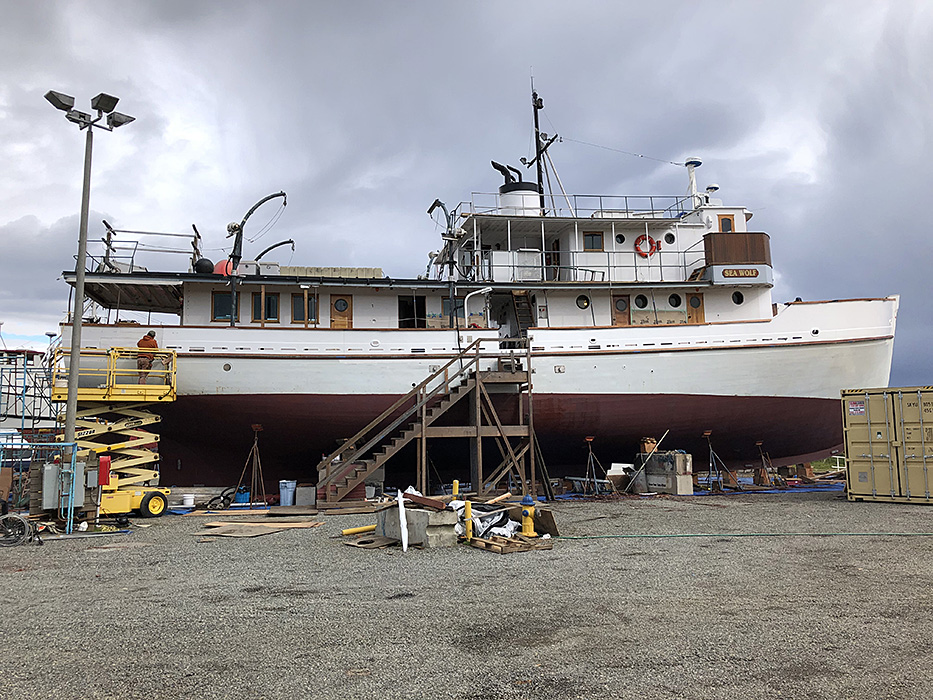
The Sea Wolf high and dry in the Port Townsend boatyard, a few days before we left for Alaska.
Eventually we left Port Townsend on April 13th. A lot of work had to be done on the ship, both inside and out, as we traveled up through the B.C. Inside Passage. Luckily, after the first stormy day at sea, we had excellent calm weather all rest of the way to Ketchikan.
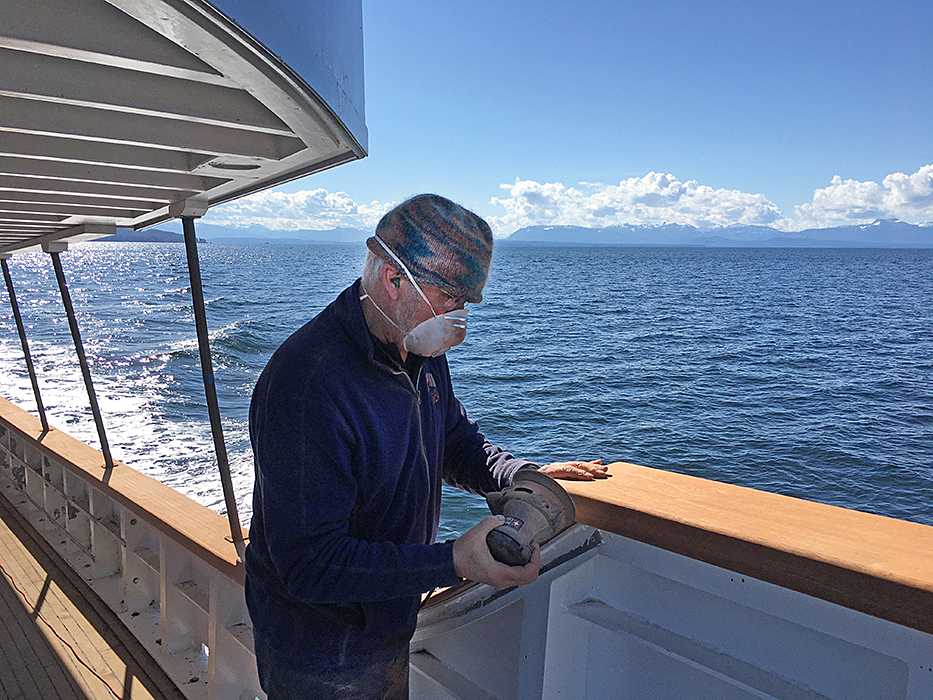
Getting the ship into shape – sanding the new caprail as we cruised through the BC inside passage.
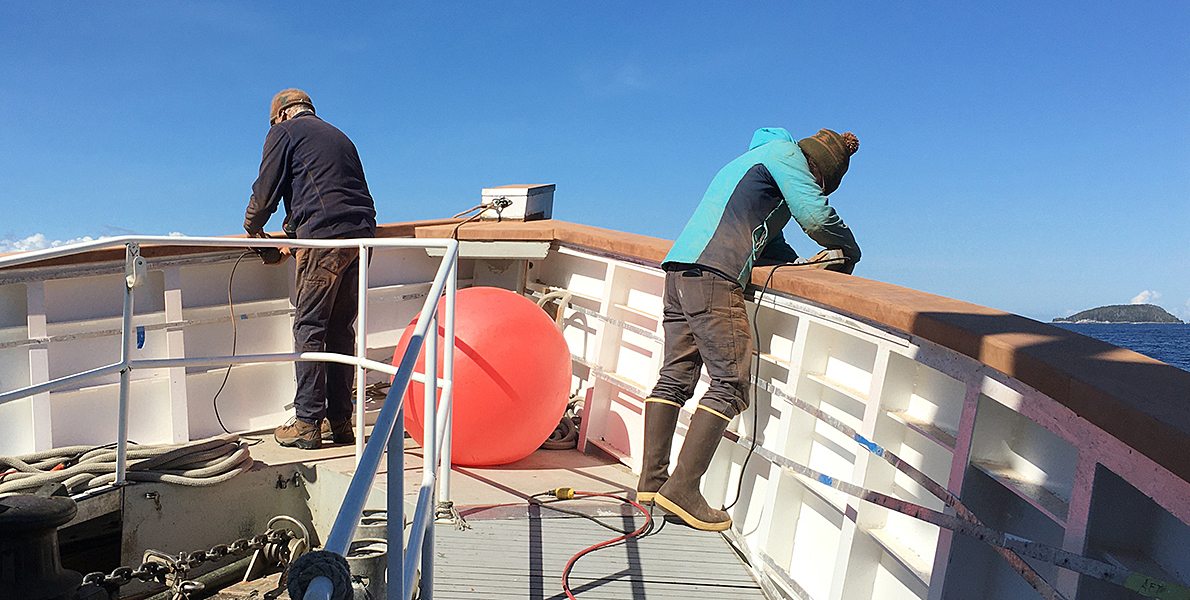
Alan and Emma, one of the Sea Wolf naturalists, sanding the caprail at the bow.
The birding was good all the way up the BC Coast. In several locations near colonies we encountered hundreds of Rhinoceros Auklets. Huge flocks of waterfowl, loons, gulls and grebes were migrating up the coast too.
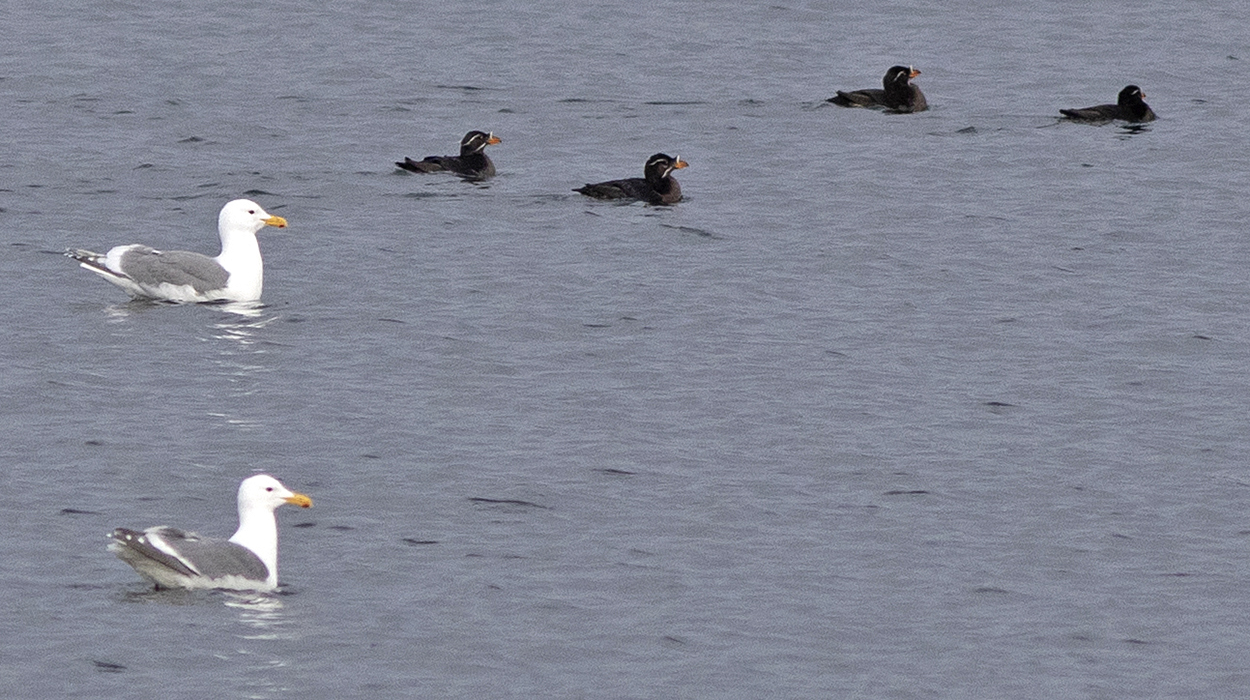
Rhinoceros Auklets along with two Glaucous-winged Gulls near the Washington/B.C. border. Photo: © Alan Burger
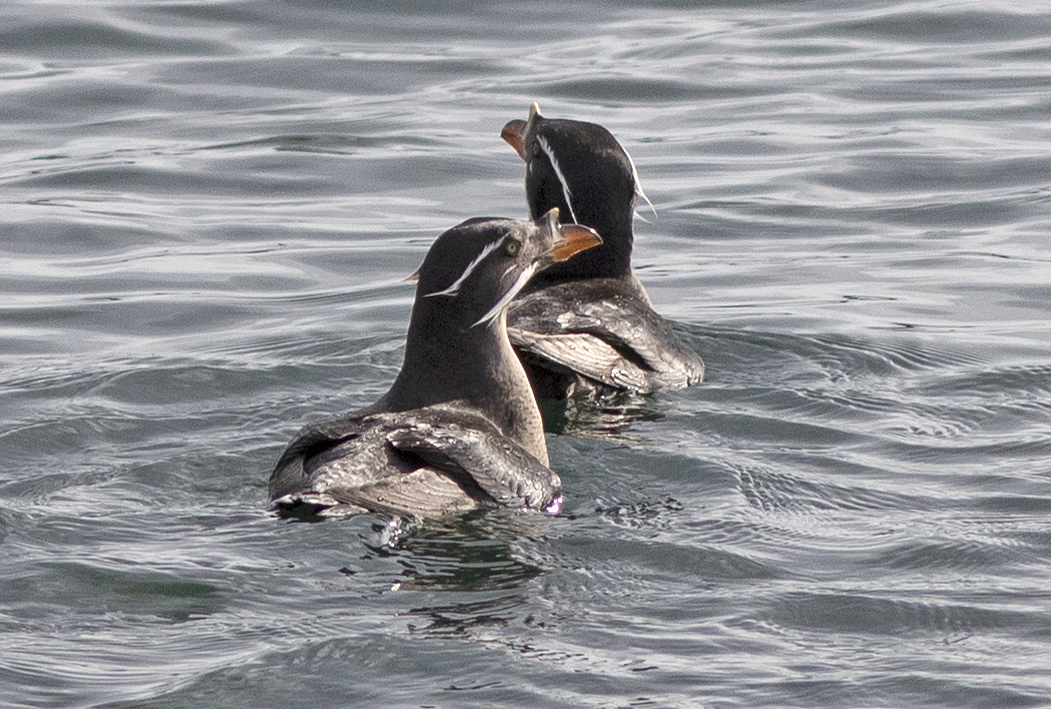
Rhinoceros Auklets in breeding plumage. Photo: © Alan Burger
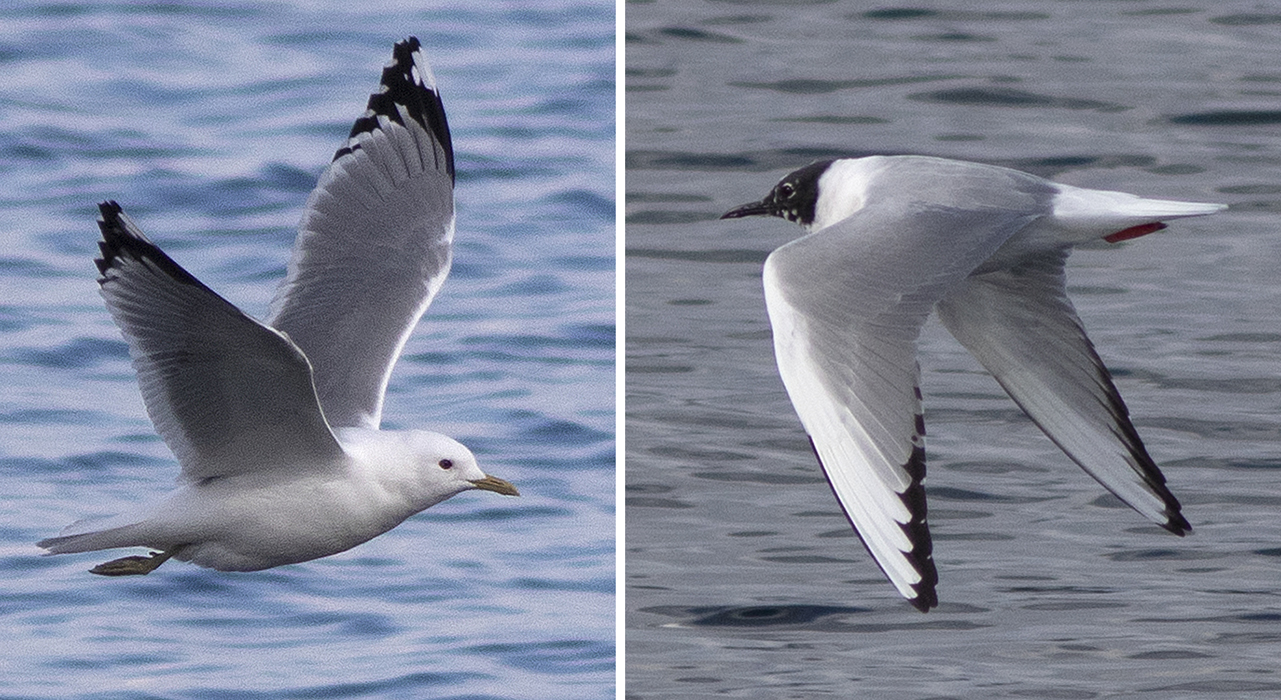
These two gull species were extremely common throughout B.C. and southeast Alaska during our travels: Short-billed Gull (until recently known as Mew Gull) left and Bonaparte’s Gull right. Photos: © Alan Burger
And with good weather we could appreciate the stunning scenery of the B.C. coast – a seemingly endless array of lofty snowy mountains making a fitting backdrop for the lush coastal rainforest.
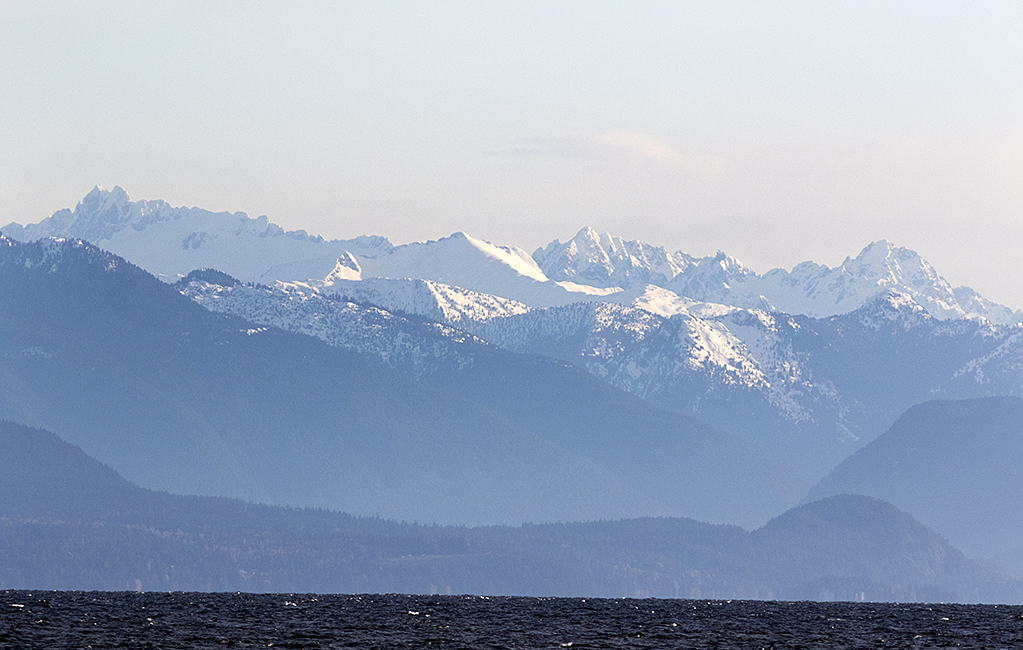
Some of the mountain scenery along the B.C. coast – Mount Waddington range.
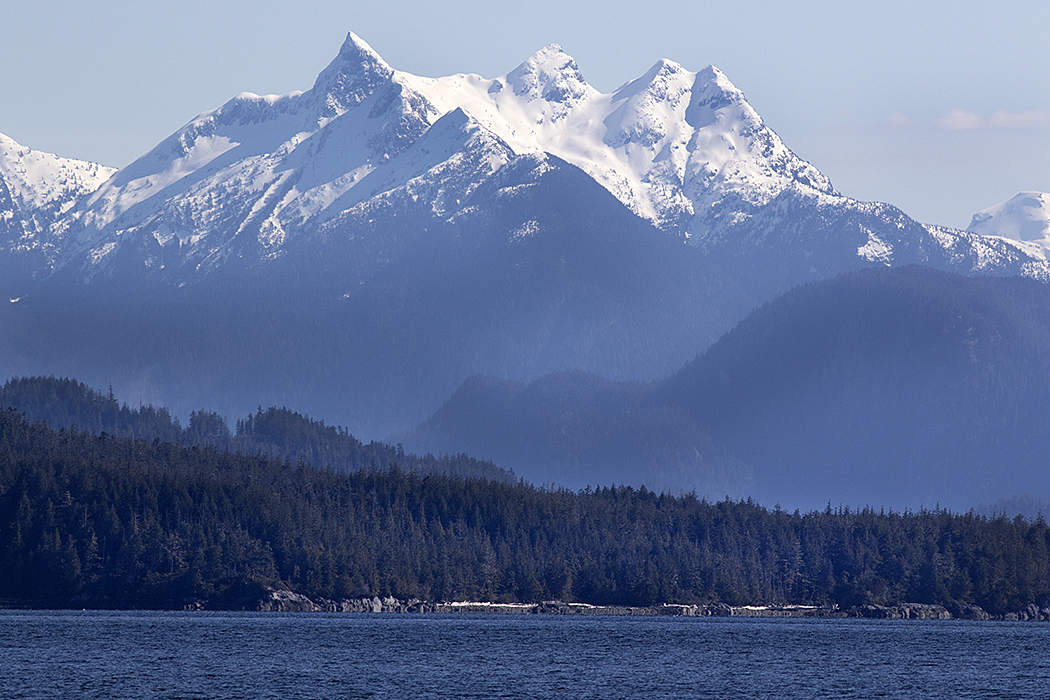
Yet another lovely mountain along the B.C. Inside Passage.

These were some of the 3,000 Surf Scoters that were massed in the shallows near Ivory Island in the central B.C. coast. We encountered several huge flocks of this species. They usually aggregate in places where herring are spawning.
We had great views of several marine mammal species along the way – many Harbour Porpoise, a few Dall’s Porpoise, a couple of Humpback Whales, a lively pod of Pacific White-sided Dolphins, Harbour Seals and California and Steller’s Sea Lions.
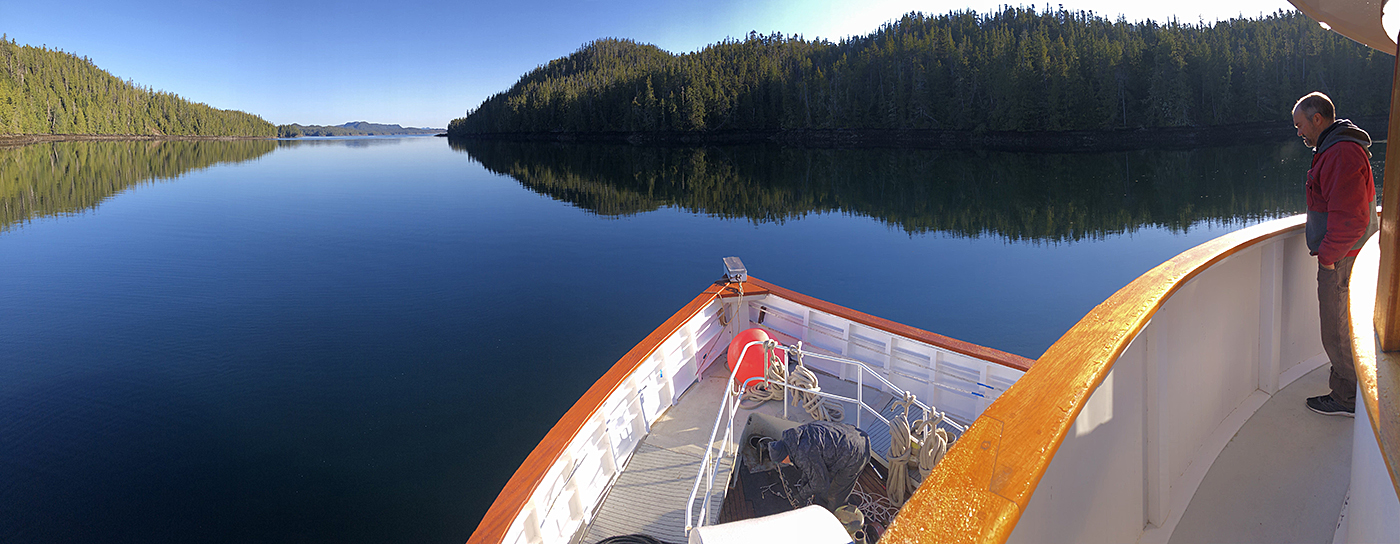
A beautiful calm morning in Bob Bay near Bella Bella. Captain Hans looks on as the engineer Joe raises the anchor.
Despite long days of travel we still had to travel through the night on our last leg in order to get to Ketchikan on time. We took turns through the night assisting the person on watch in the wheelhouse to look out for floating logs – luckily we had a full moon to assist.
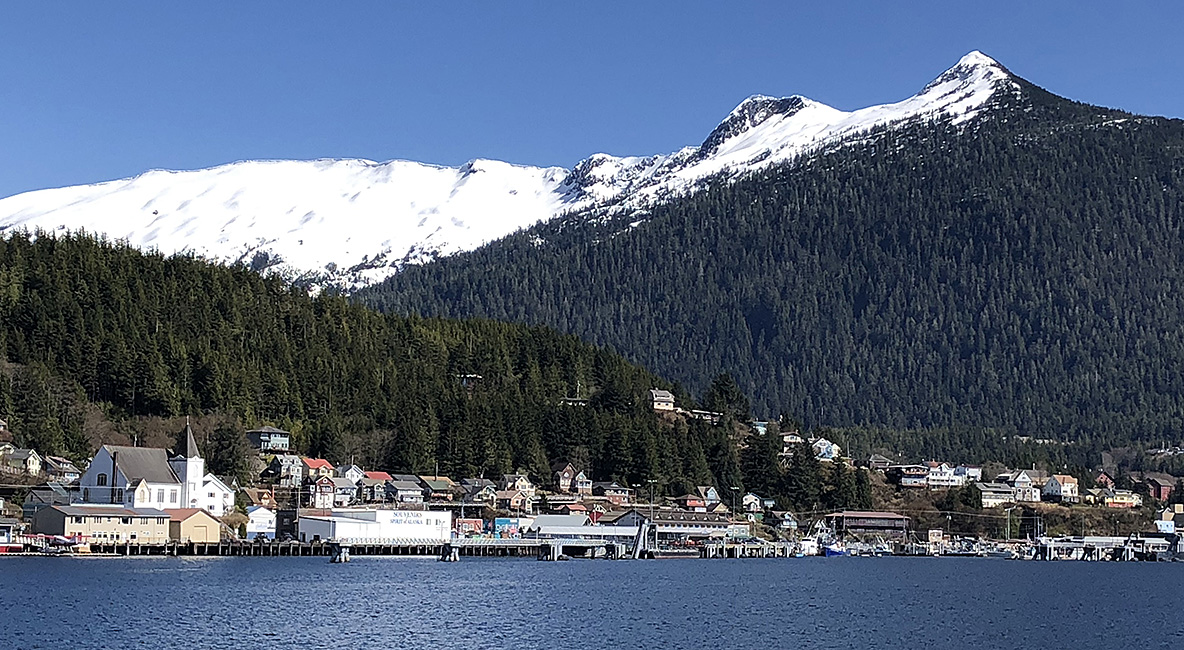
Arrival at Ketchikan, the southernmost town in Alaska, on April 17th.
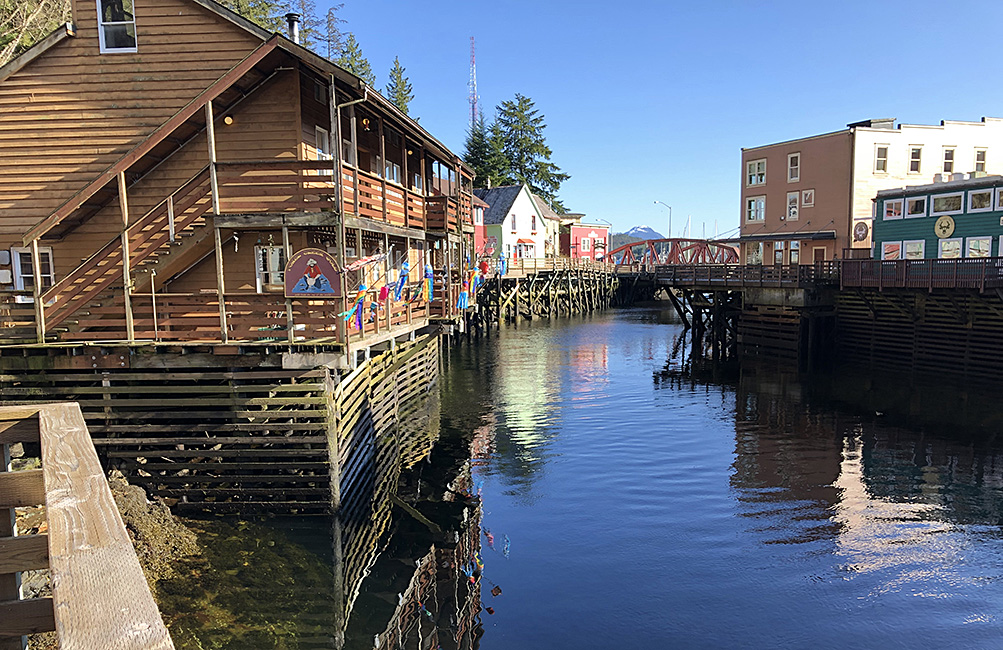
Ketchikan has a very colourful history – several of these dockside homes served as brothels and speakeasies during the goldrush days. Now they attract huge numbers of tourists when the big Alaska cruise ships stop by.
We met our eight passengers on April 18th. Several of them had been on the Sea Wolf in previous years. All were seasoned travelers with lots of past experiences and all were great shipboard companions. We spent the first day exploring the Ketchikan area while the ship’s crew feverishly did the last-minute preparations.
A nice hike at Settler’s Cove State Park produced great views of several interesting birds plus a River Otter along the shoreline.
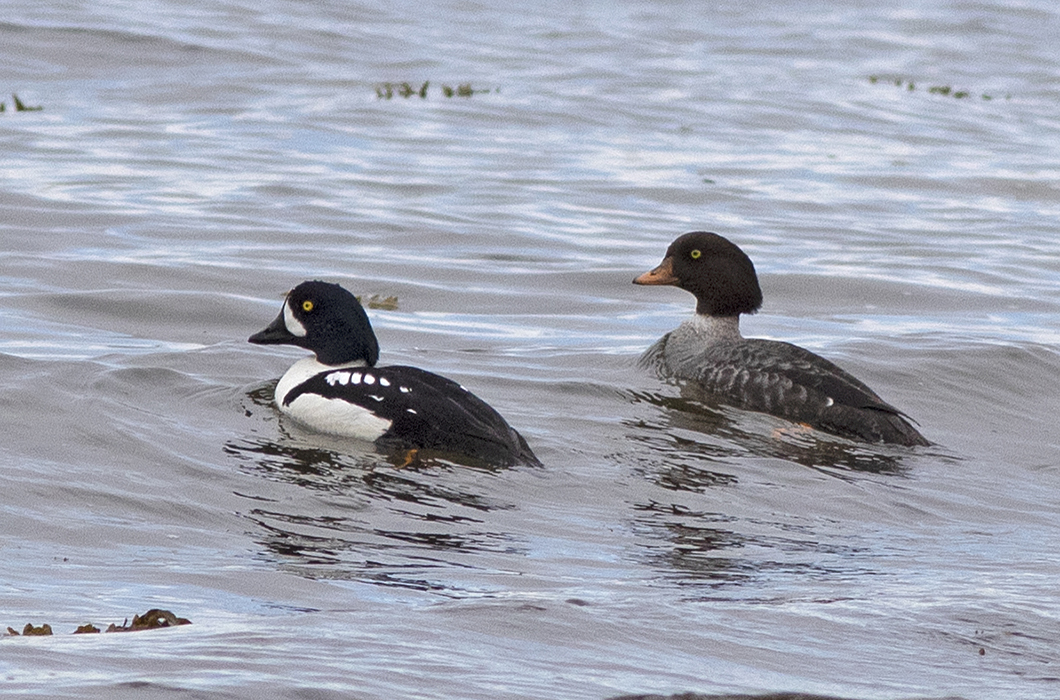
A pair of Barrow’s Goldeneyes at Settler’s Cove park, Ketchikan. Male left, female right. Photo: © Alan Burger
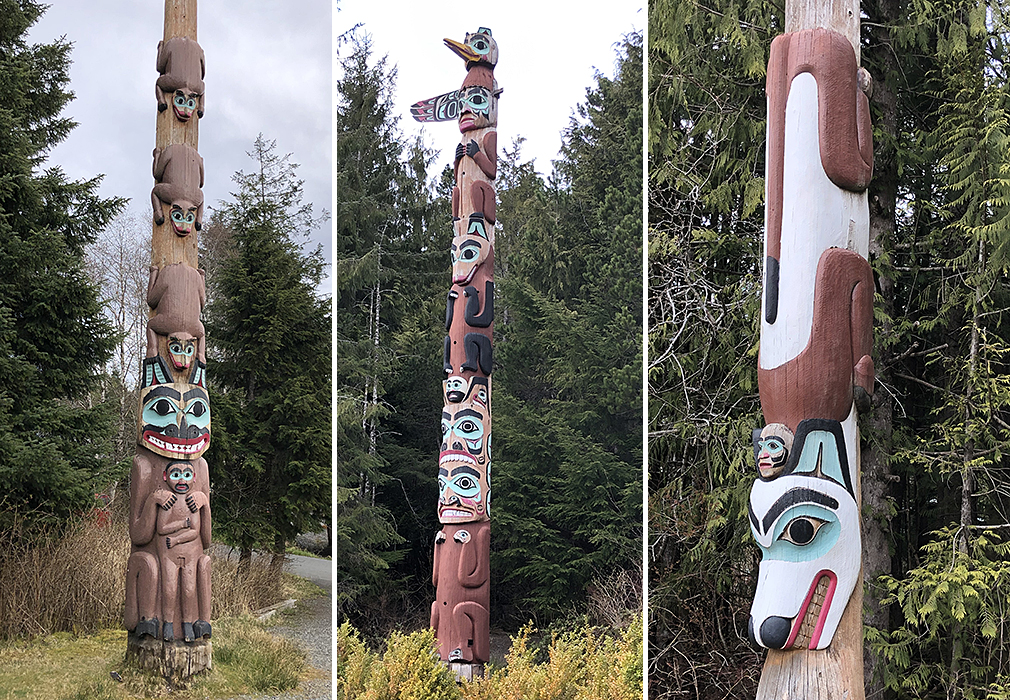
A sample of the Tlingit totem poles – both old and new at the Saxman Reservation in Ketchikan. The carving school here teaches young Tlingit the traditional skills needed for totems, long-houses and other native arts.
Leaving Ketchikan we spent the next two days in the Misty Fiords National Monument – a wonderful wilderness of high mountains, deep steep fjords and interesting wildlife. During summer this area is popular with boaters, and planes and helicopters bring tourists from the cruise ships in Ketchikan. But this early in spring, before the cruise ships arrive, we had the place to ourselves. For more than two days we saw no other boats and no aircraft.
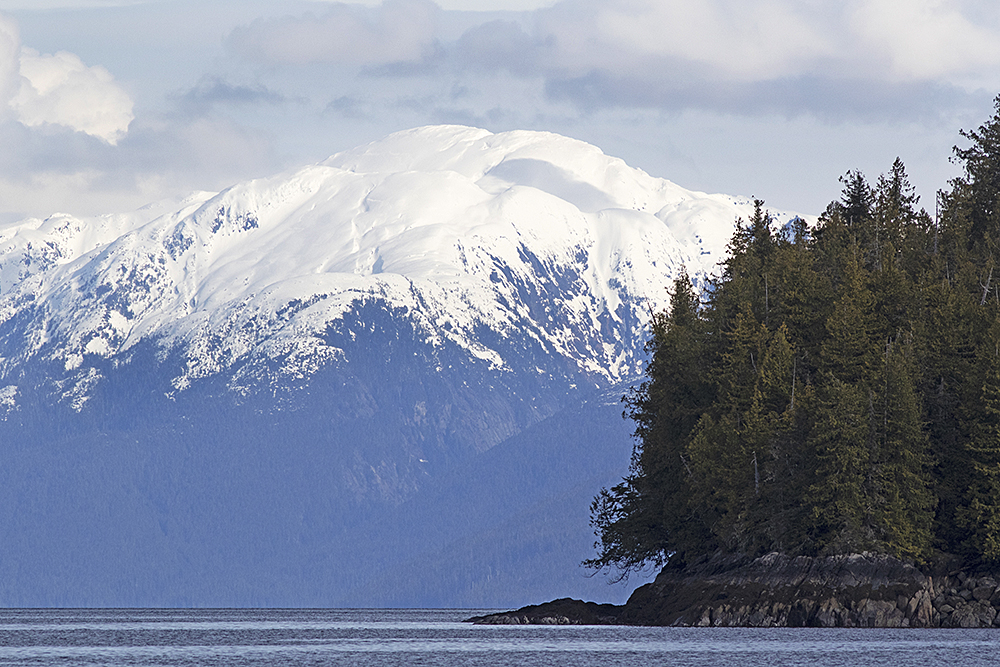
Typical scenery in Misty Fiords National Monument.
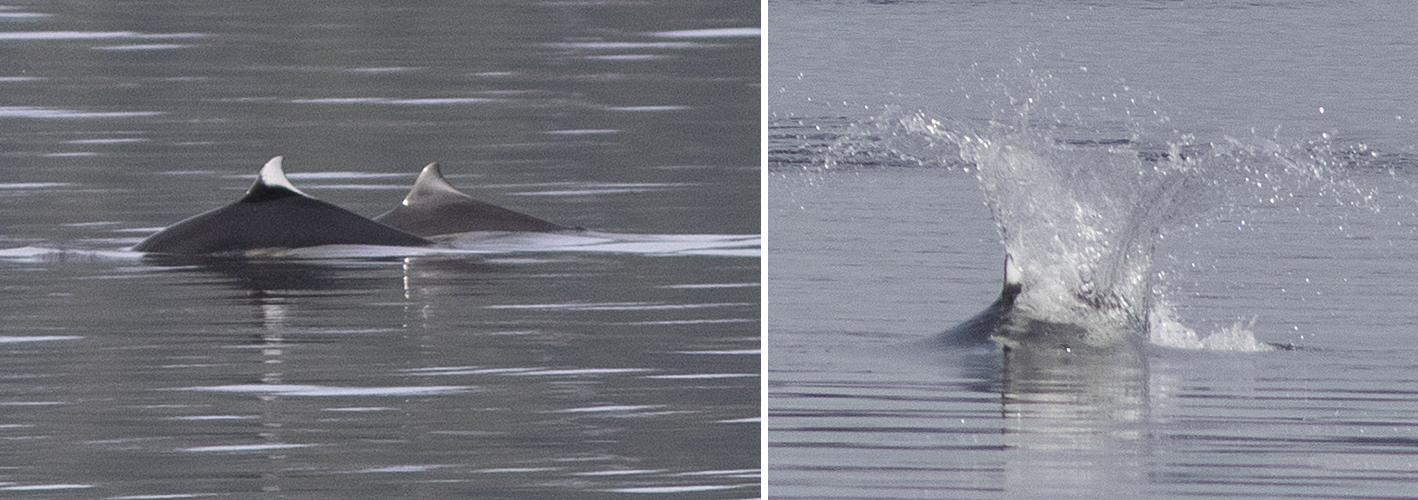
Dall’s Porpoise – the most dashing and energetic of all the porpoises. The pale one in the left photo is immature. The right photo shows the characteristic “rooster-tail” splashes as they travel at speed.
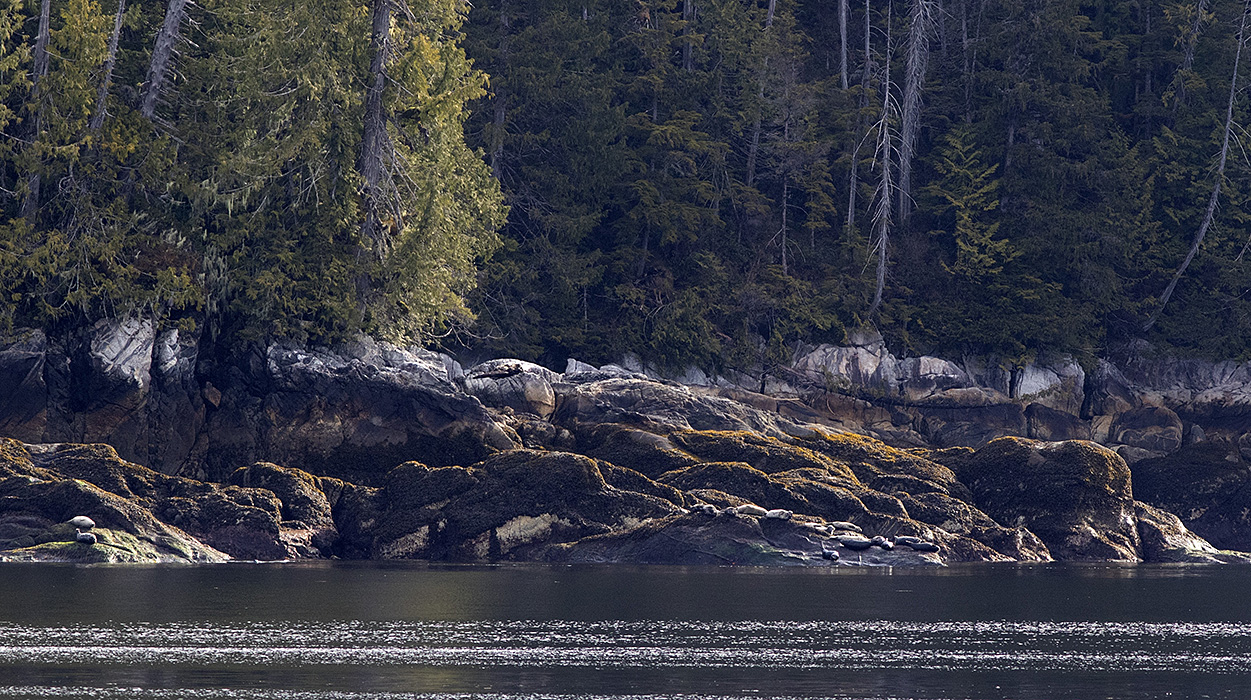
Harbour Seals hauled out on the rocks – Misty Fiords National Monument.
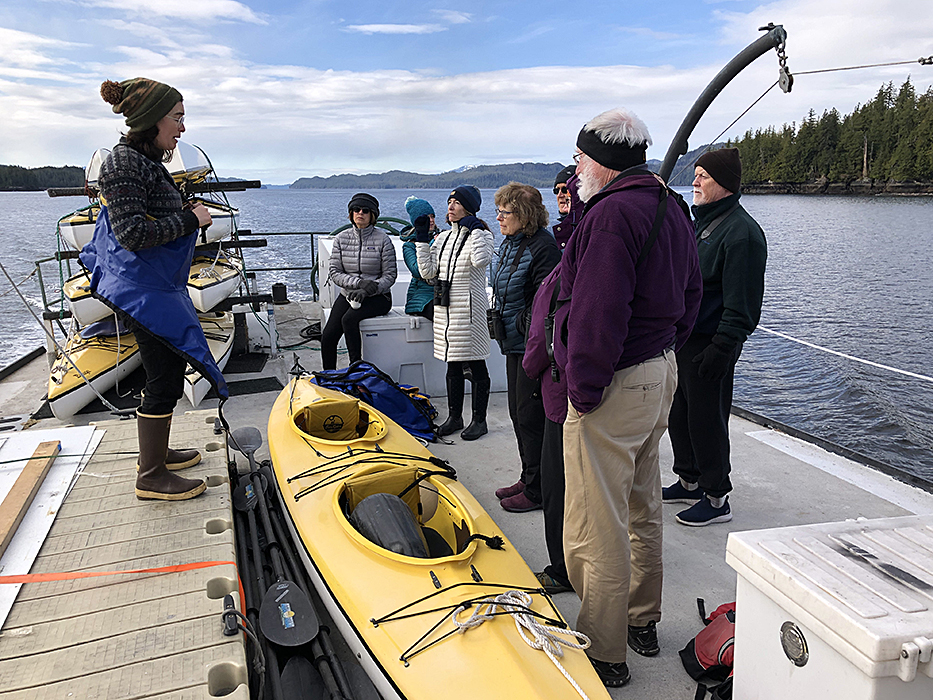
Emma leads the kayak briefing on the top deck. Getting out on the kayaks almost every day was a highlight of the trip.
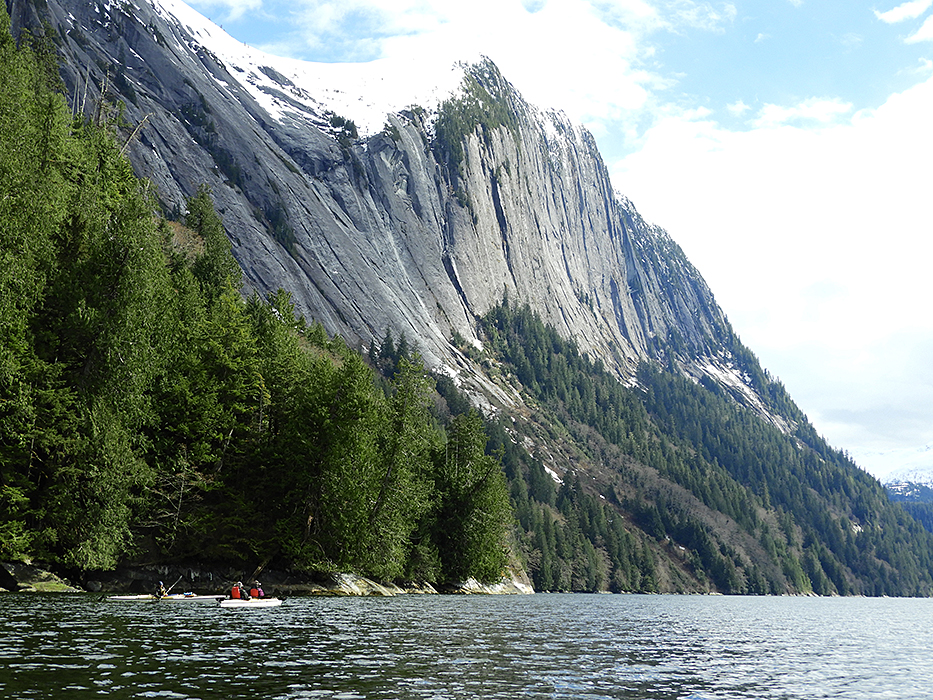
Kayaking beneath the immense glacier-sculpted cliffs in Misty Fiords.
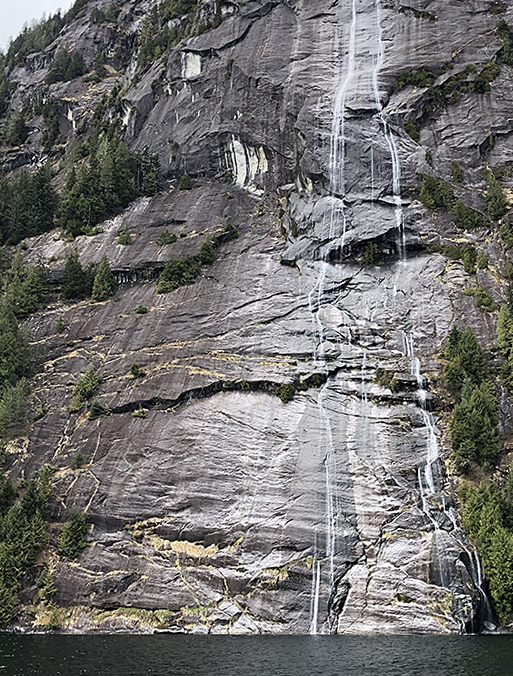
While we were admiring this impressive cliff with streaming waterfalls, we realized there was a Mountain Goat feeding near the base of the cliff. Do you see the tiny white dot on the biggest area of yellow grass? Walker Bay, Misty Fiords, 19 April 2022.
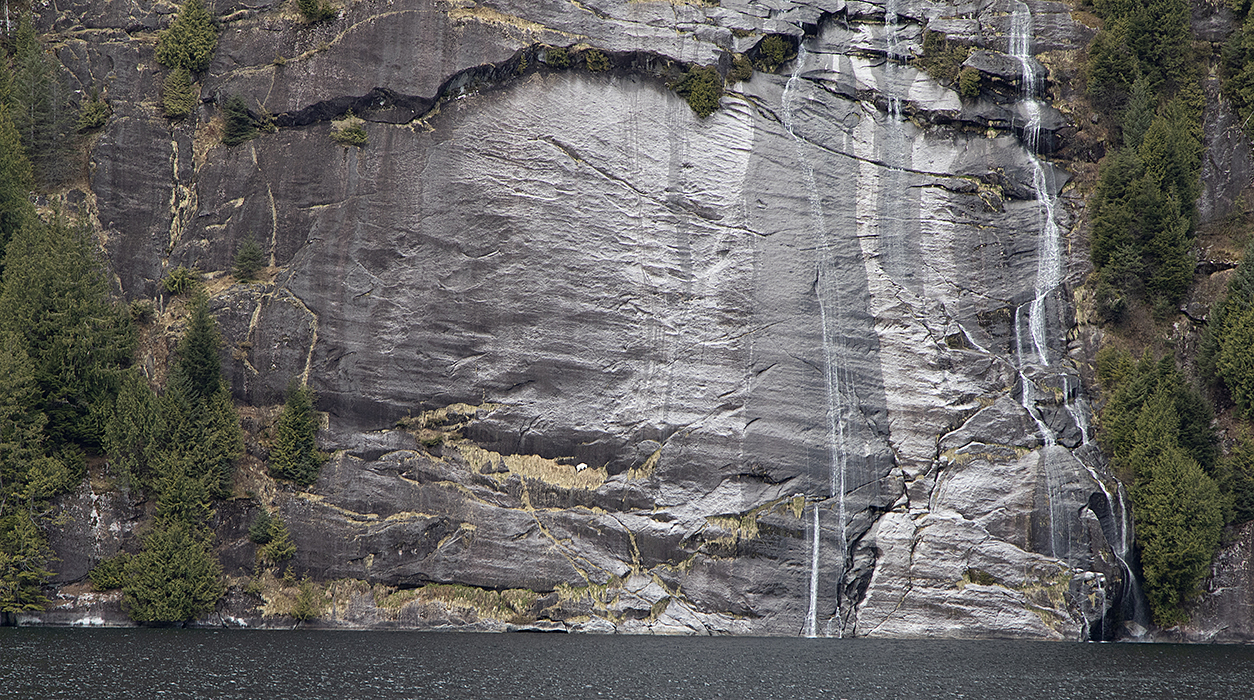
See the Mountain Goat now? That scale gives one a better appreciation of the height of these ice-scoured near-vertical cliffs.
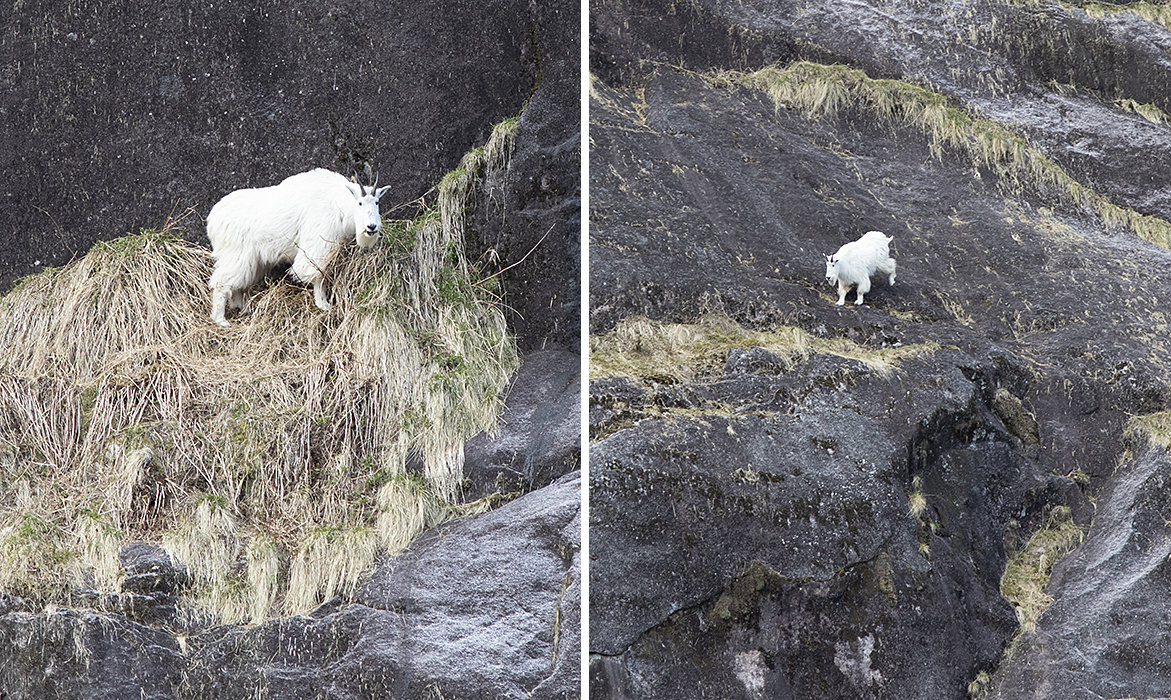
The boat moved closer so we could get a better look at this intrepid billy Mountain Goat. While we watched he casually strolled down the near-vertical rock face and moved away into some trees.
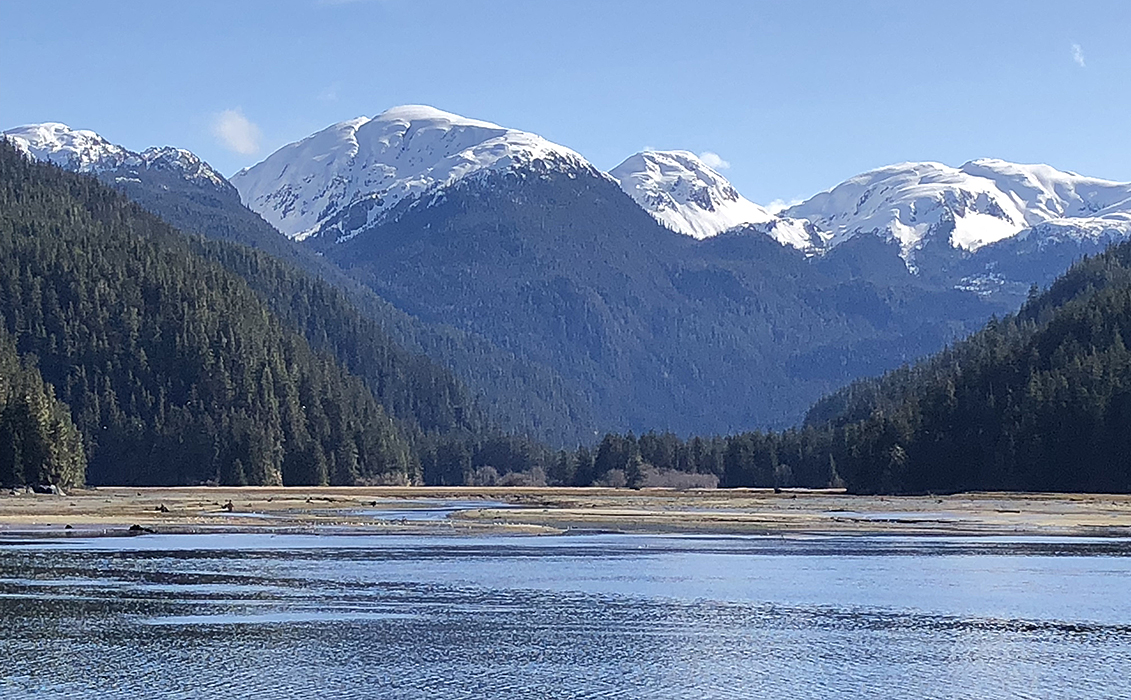
The Uluk and Klahini Rivers share this beautiful estuary in Misty Fiords. The mountains form the boundary between Alaska and British Columbia.
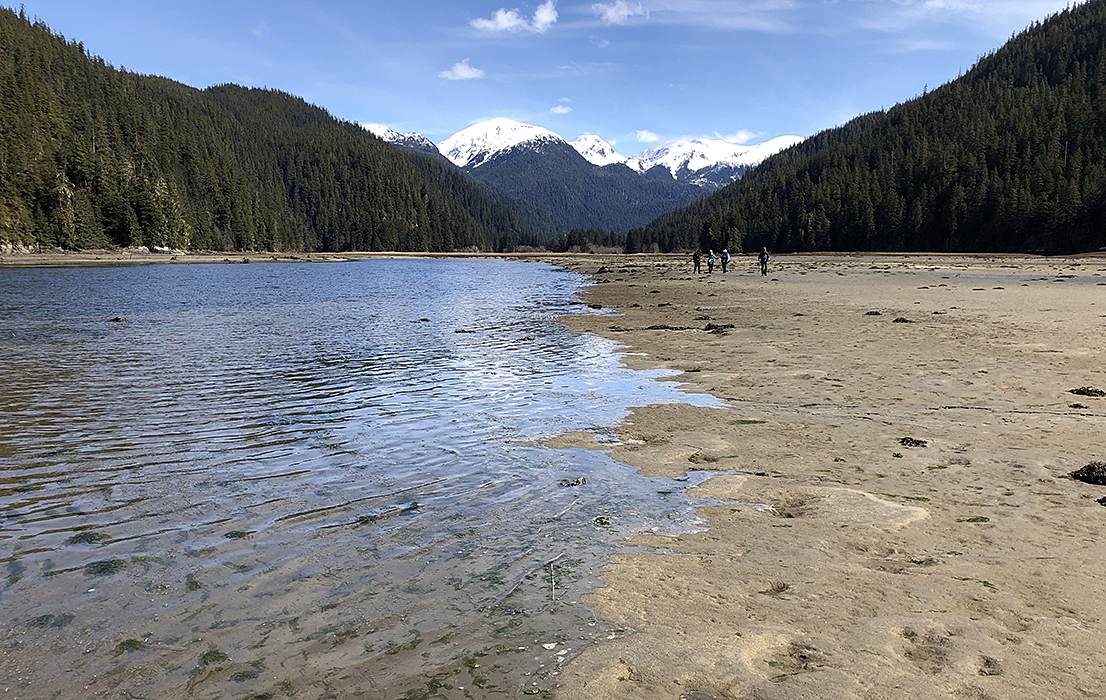
Exploring the Klahini River estuary.
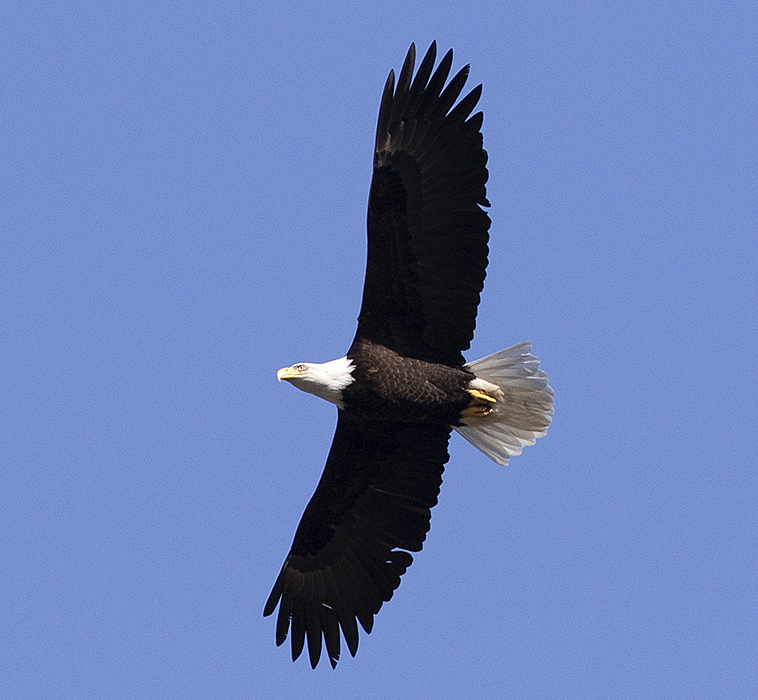
An adult Bald Eagle, Klahini estuary. These eagles are common in coastal Alaska and we saw them every day on our trip.
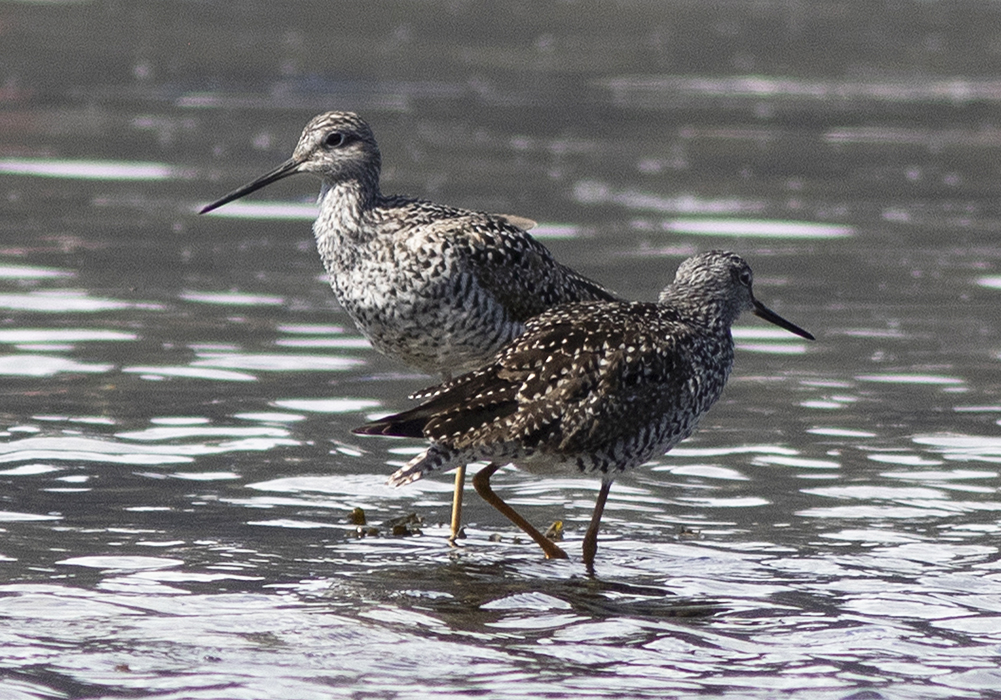
Greater Yellowlegs at Klahini estuary.
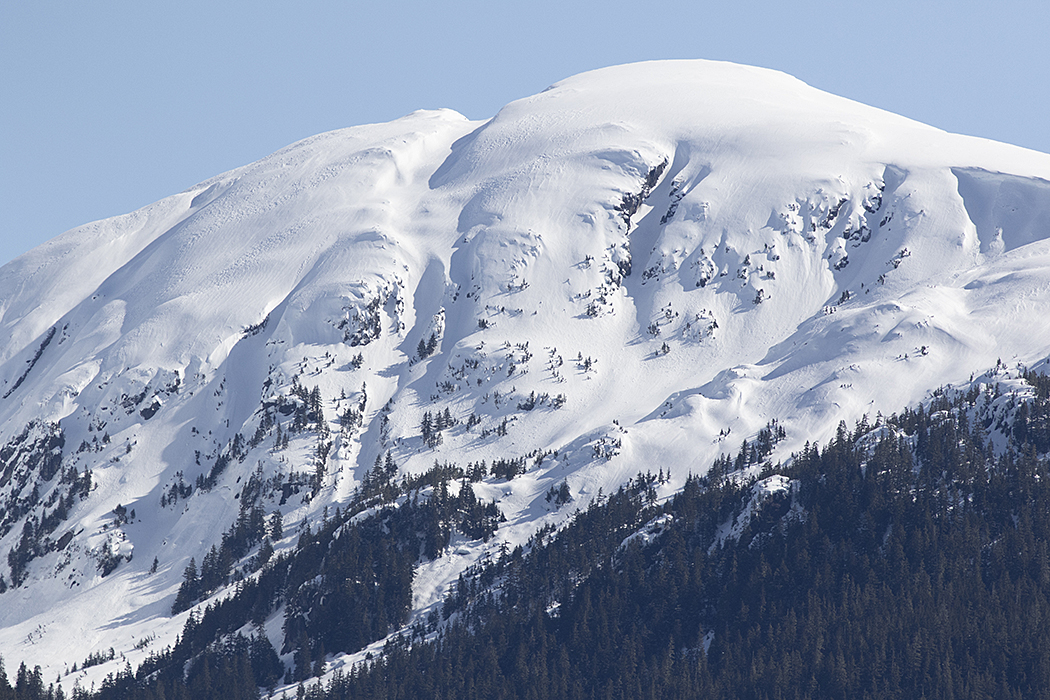
A mountain in Misty Fiords. Many of the high mountains in southeast Alaska have this dome shape – the result of glaciers scouring, even over the summit, during thousands of years of glaciation.
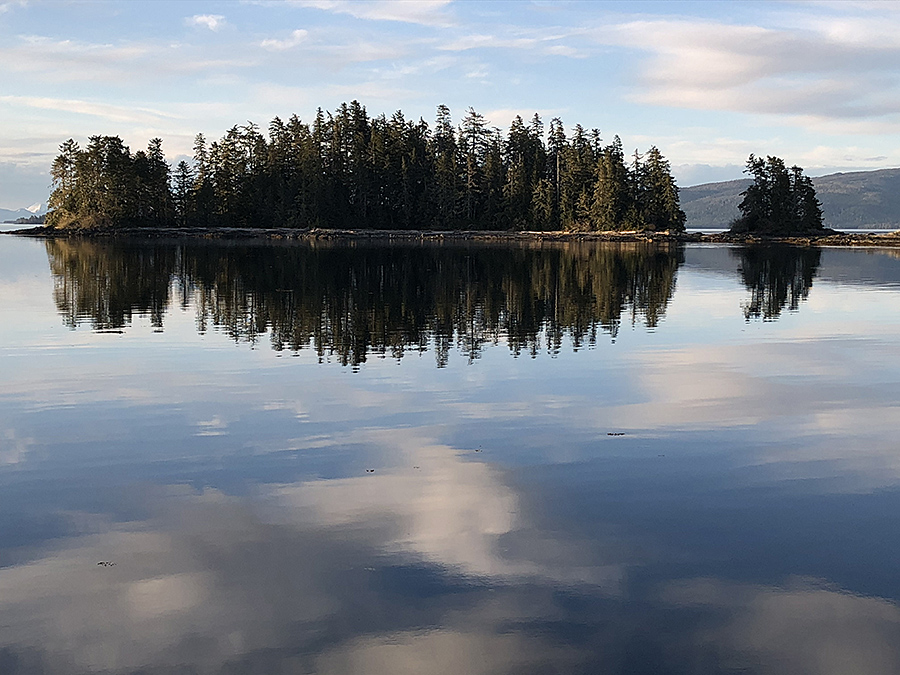
A beautiful calm morning on 21 April near Snow Passage, southeast Alaska.
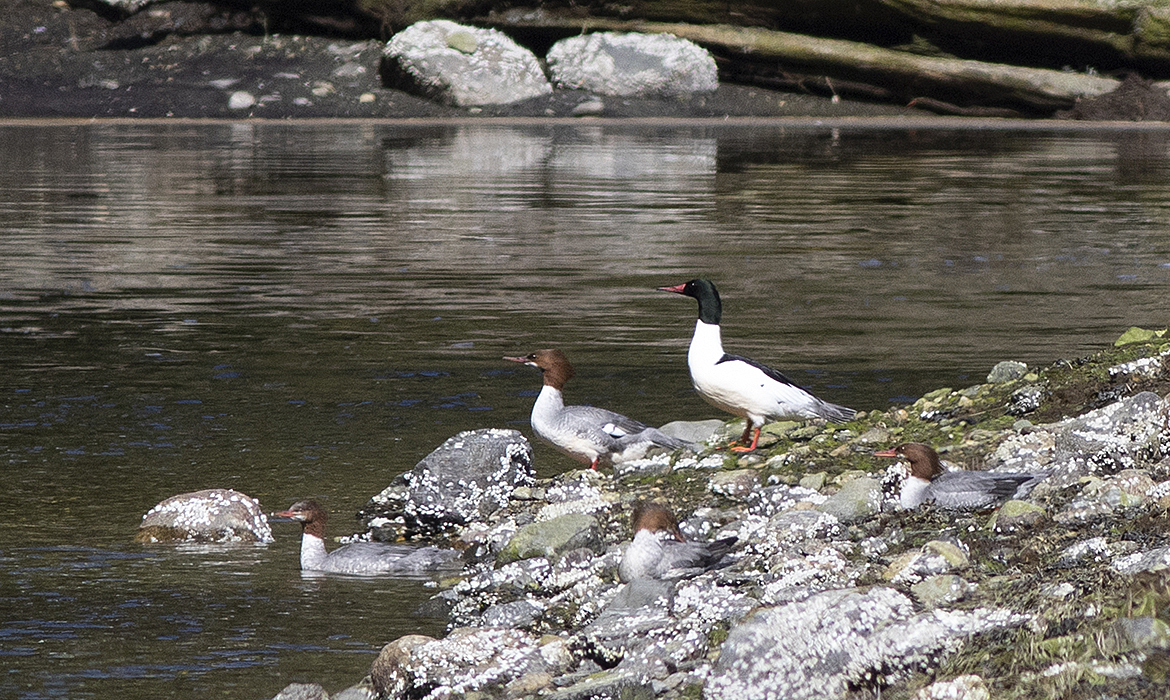
Common Mergansers at McHenry Inlet – 21 April 2022.
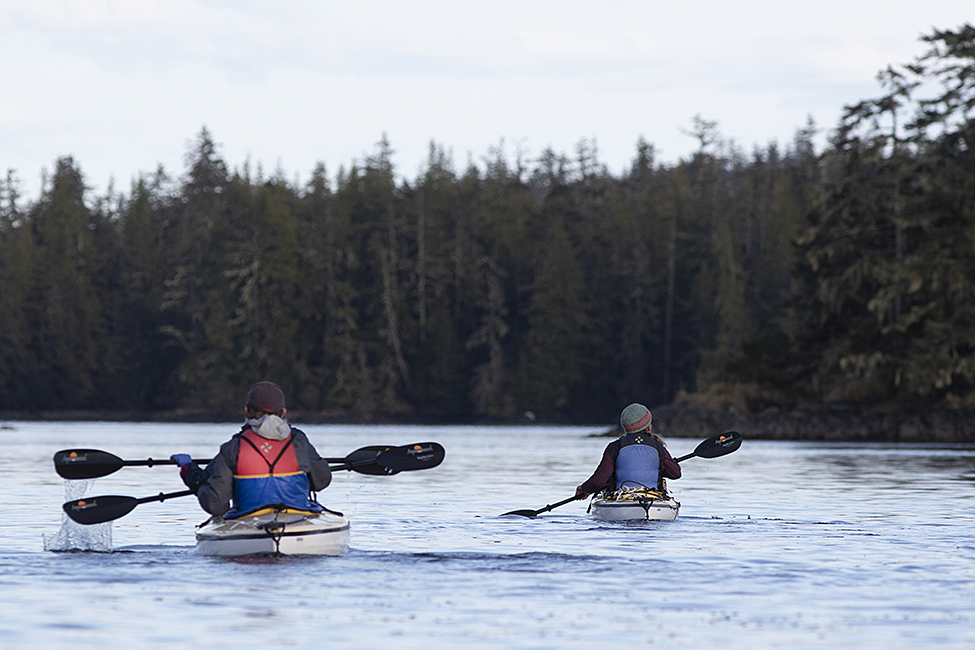
Kayaking in the Kashverof Islands.
For part of our voyage we were along the Pacific Flyway – a major migration pathway for millions of birds heading to mainland Alaska to breed. Some, like these Snow Geese and Sandhill Cranes even continue across the Bering Strait and breed in the Russian Far East.
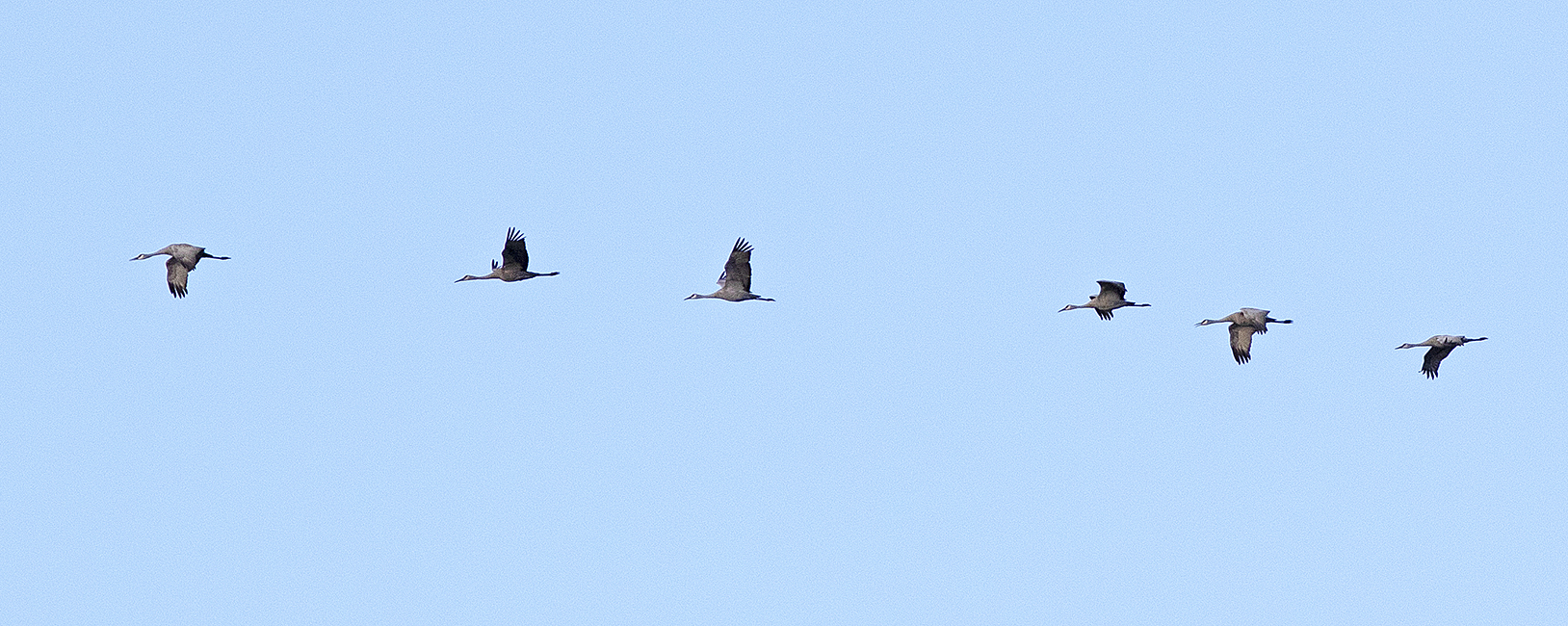
A high-flying flock of Sandhill Cranes heading for northern breeding grounds. Photo: © Alan Burger
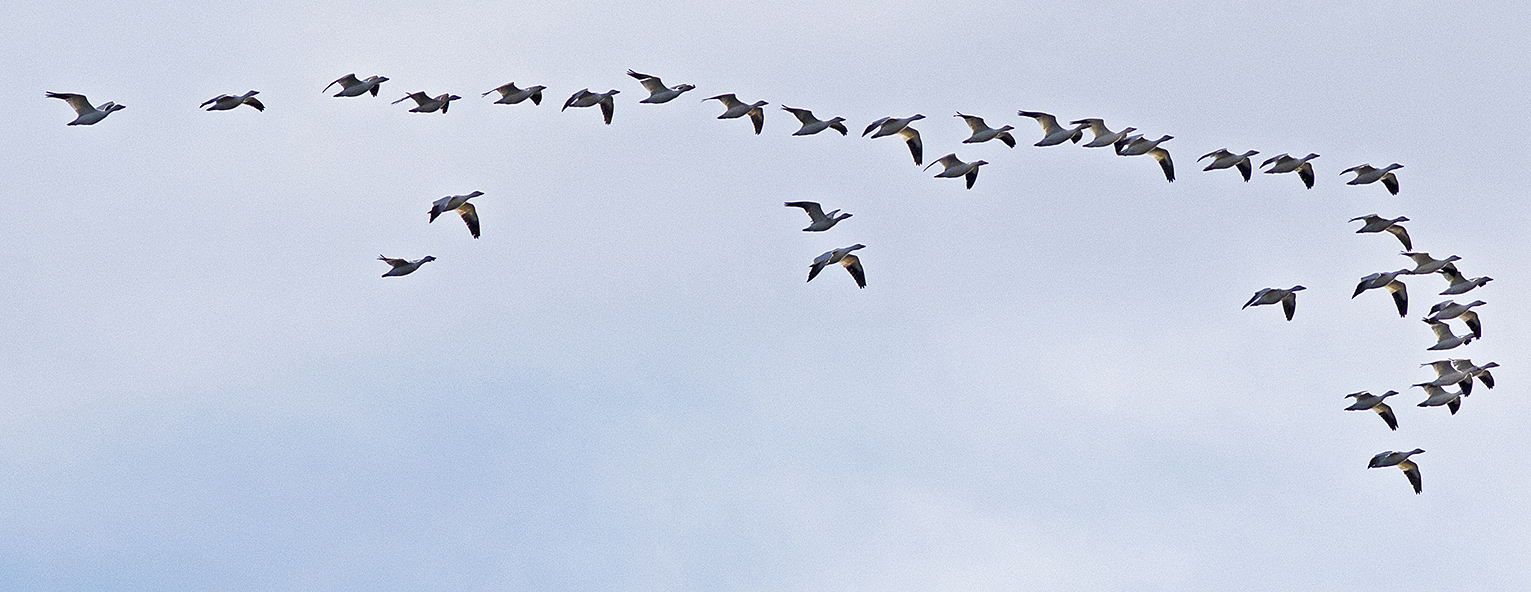
Migrating Snow Geese over the Kashverof Islands, 21 April 2022. Photo: © Alan Burger
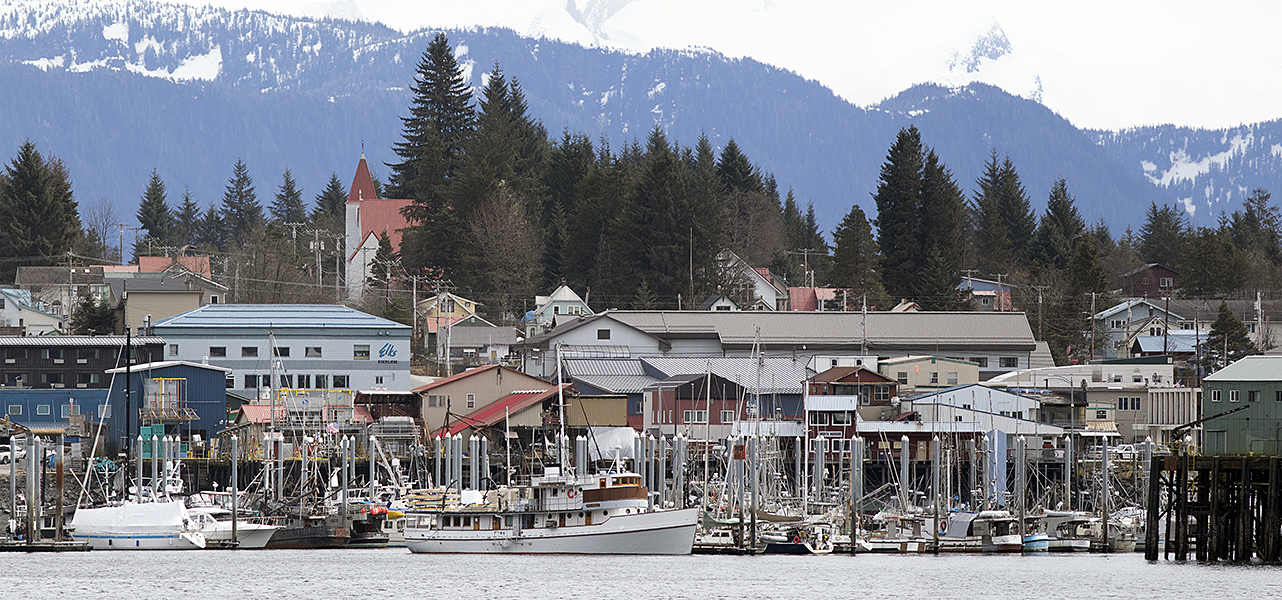
Petersburg was our only town stop between Ketchikan and Juneau. We dropped off engineer Joe and picked up fresh groceries. The Sea Wolf is at the wharf at the centre of the photo.
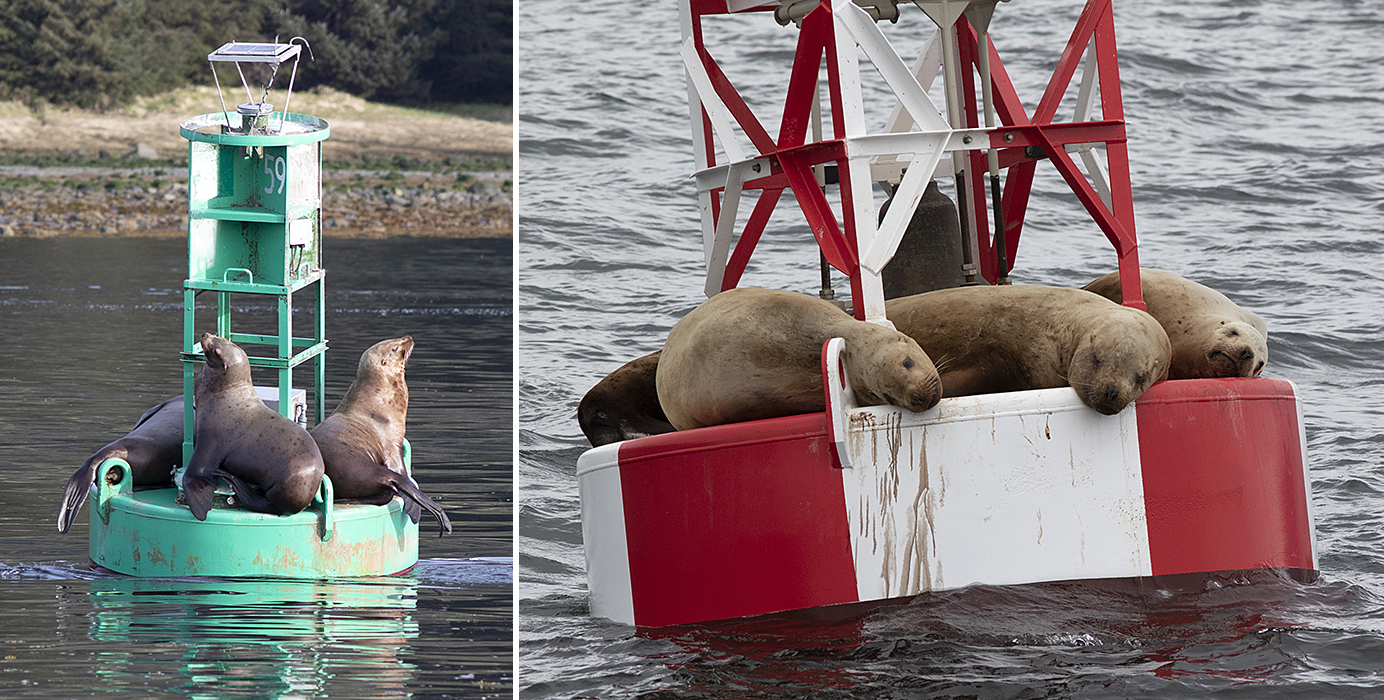
Navigation buoys make convenient resting spots for Steller’s Sea Lions in Petersburg harbour. Photos: © Alan Burger
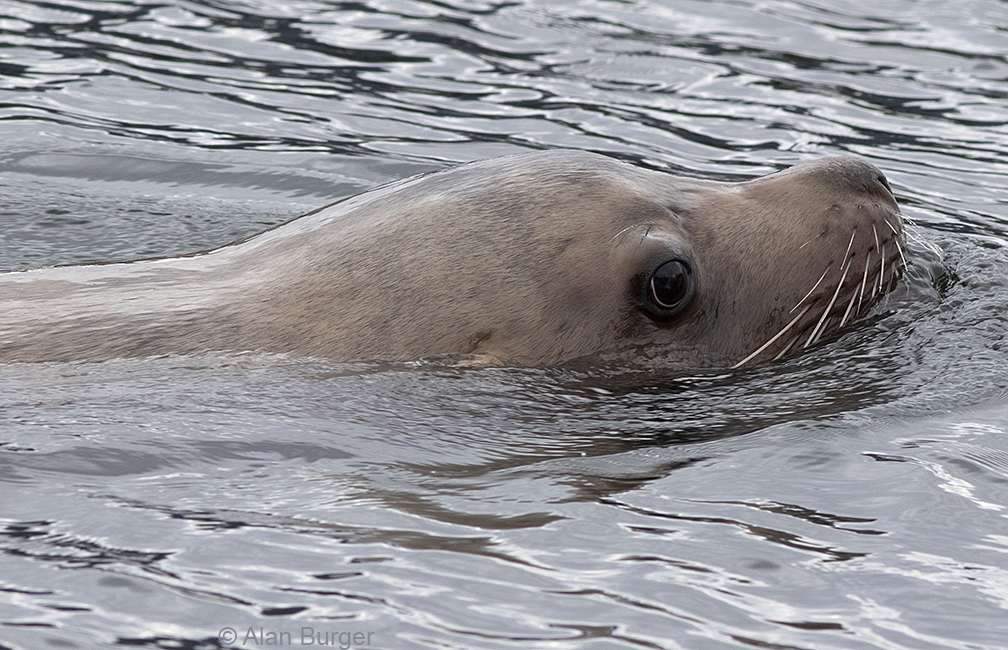
This big male Steller’s Sea Lion came cruising by to check us out as we took the skiff across Petersburg harbour to go on a hike. Photo: © Alan Burger
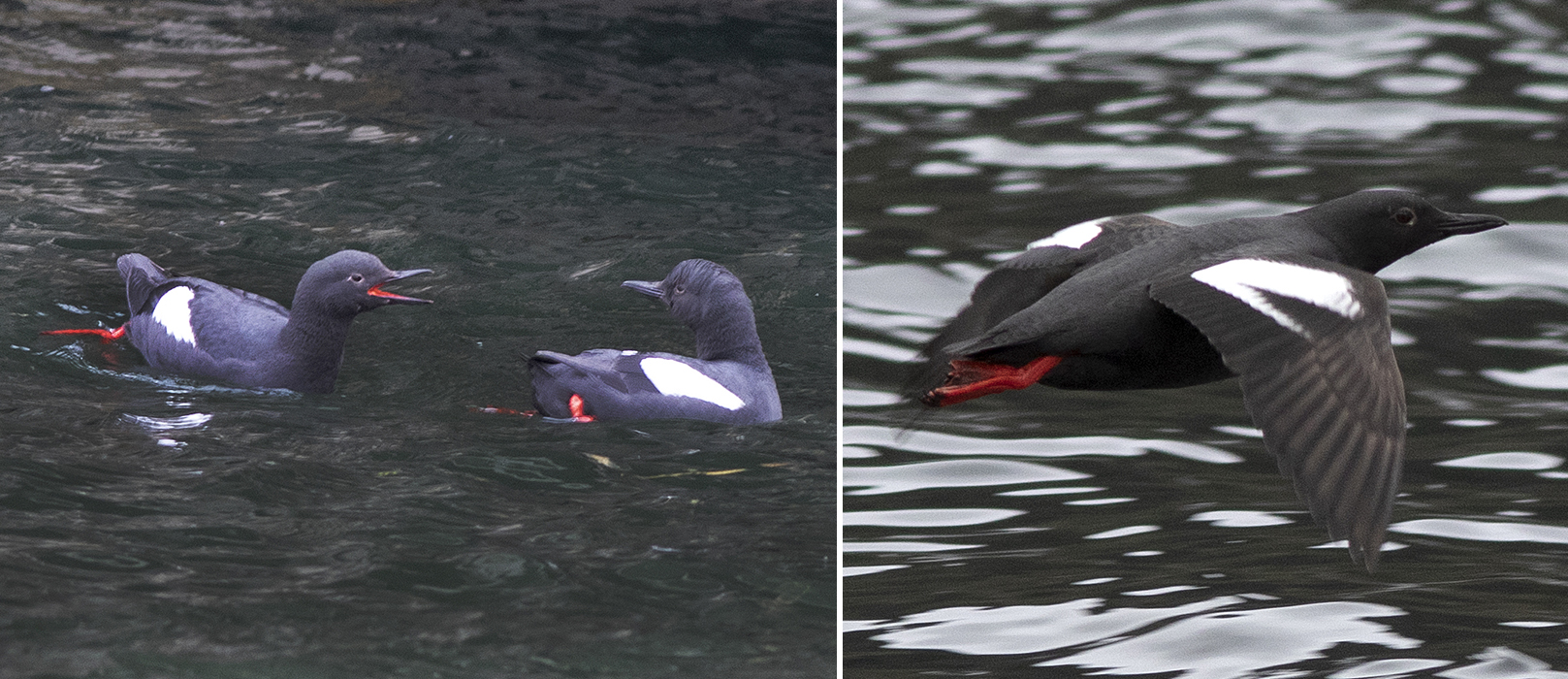
Pigeon Guillemots provided entertainment at the Petersburg wharf. A group of 30 or more were nesting under the decking of a tall fisheries wharf and displaying on the water nearby. Photos: © Alan Burger
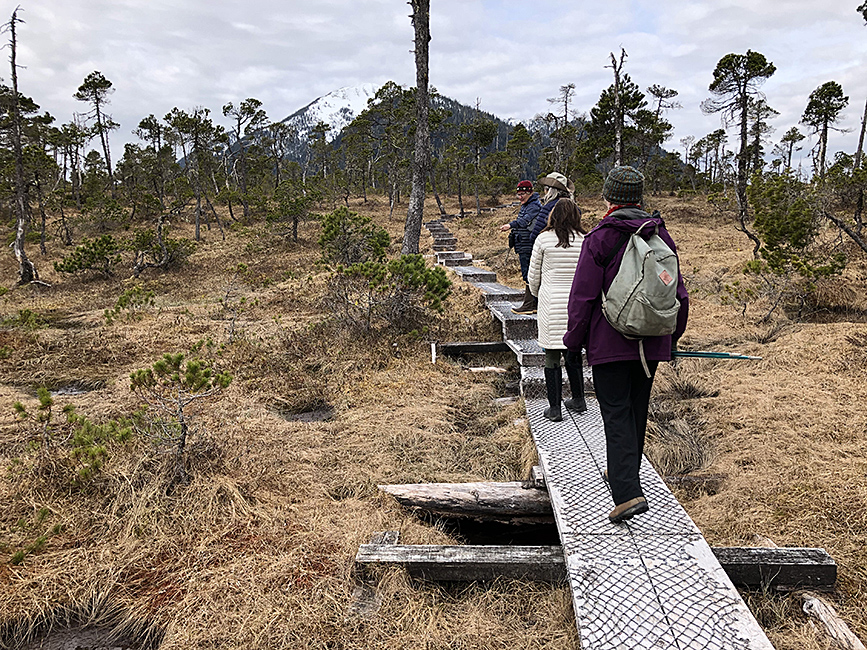
Hiking on the boardwalk at the Kupreanof muskeg trail near Petersburg, 22 April 2022.
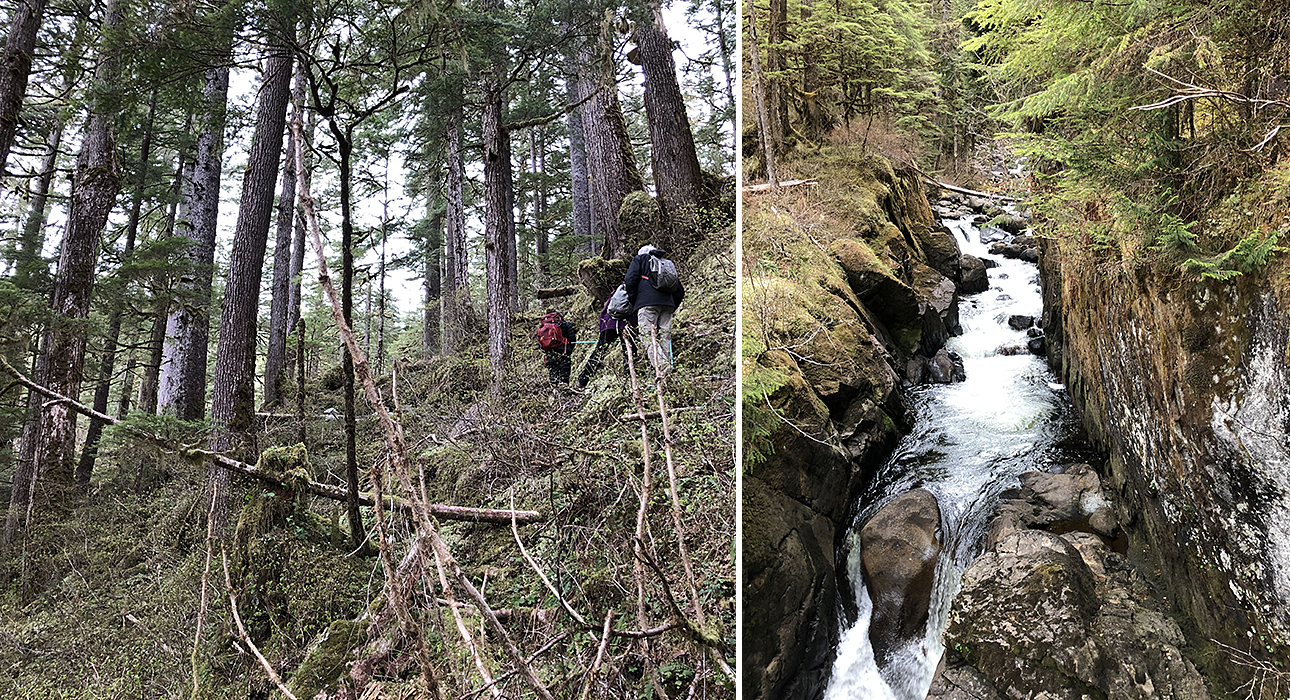
A late afternoon hike at Cascade Creek on Kupreanof Island. A stiff climb through the forest had its rewards with views of a lovely cascading creek.
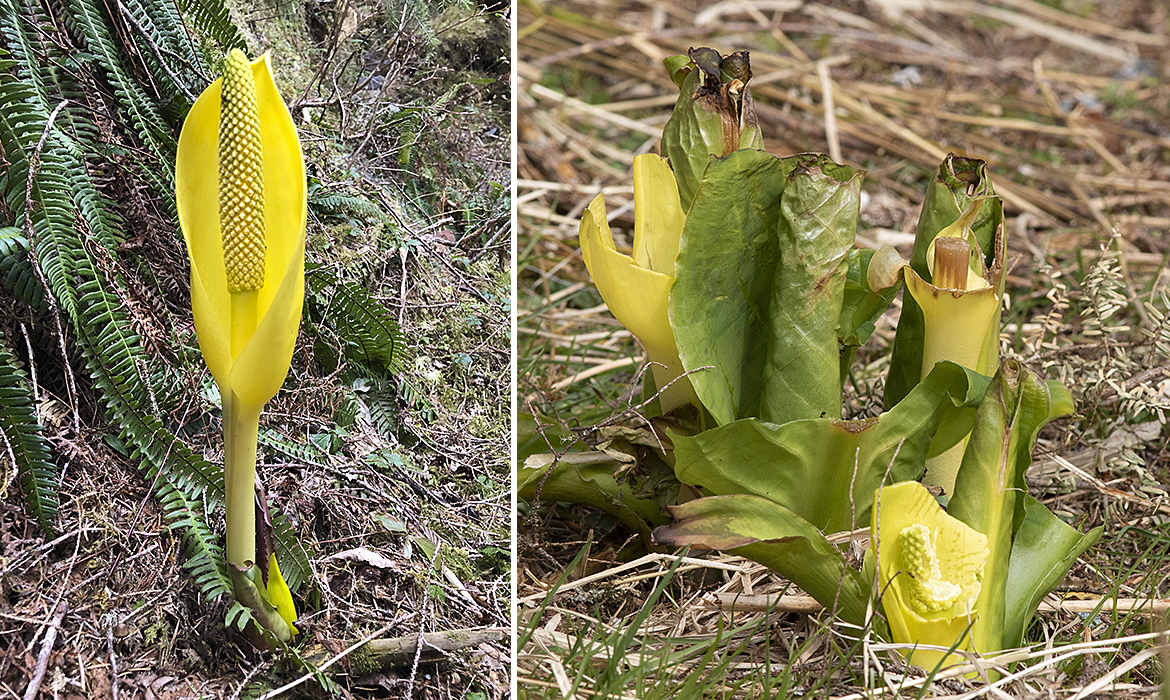
Skunk Cabbage was just coming into bloom. The flower spathe emerges before the leaves. Bears and deer find these flowers and leaves tasty despite their skunky smell, and many of them were chomped. Photos: © Alan Burger
A highlight on April 23rd was an early morning skiff ride to visit the Baird Glacier.

A panorama view of the Baird Glacier. This glacier is retreating rapidly and some of our crew had been here 20 years ago when the glacier front was where there is now a large lagoon.
As the glacier retreated, the bare gravel and rock of the terminal moraine became suitable habitat for plants to colonize. Over a period of 50 years the plant succession has progressed beginning with tough pioneers like mosses and lichens, then a few grasses, and as the organic soil develops shrubs take hold, then alders and eventually Sitka spruce trees. Within the space of a few 10s of metres one can see the full range of ecological succession here.
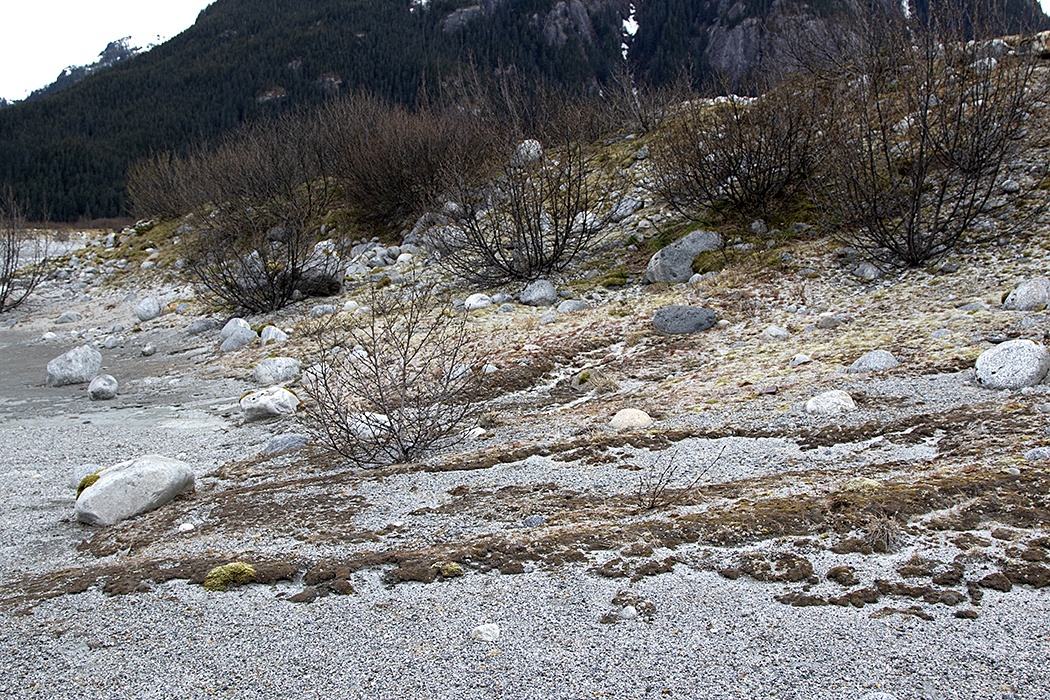
One can easily see the succession of plant colonizers on the glacier moraine – first hardy mosses and lichens, then grasses and a few shrubs, then trees. Baird Glacier, southeast Alaska.
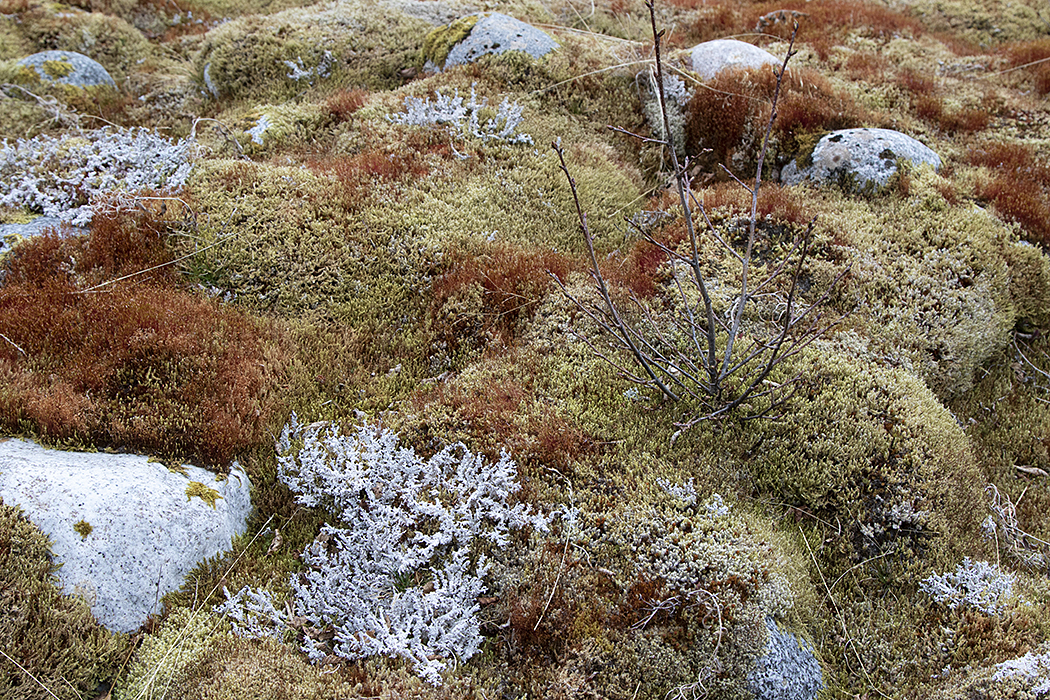
Colourful mosses and lichens are among the first colonizers of the gravelly glacial moraine. Photo: © Alan Burger
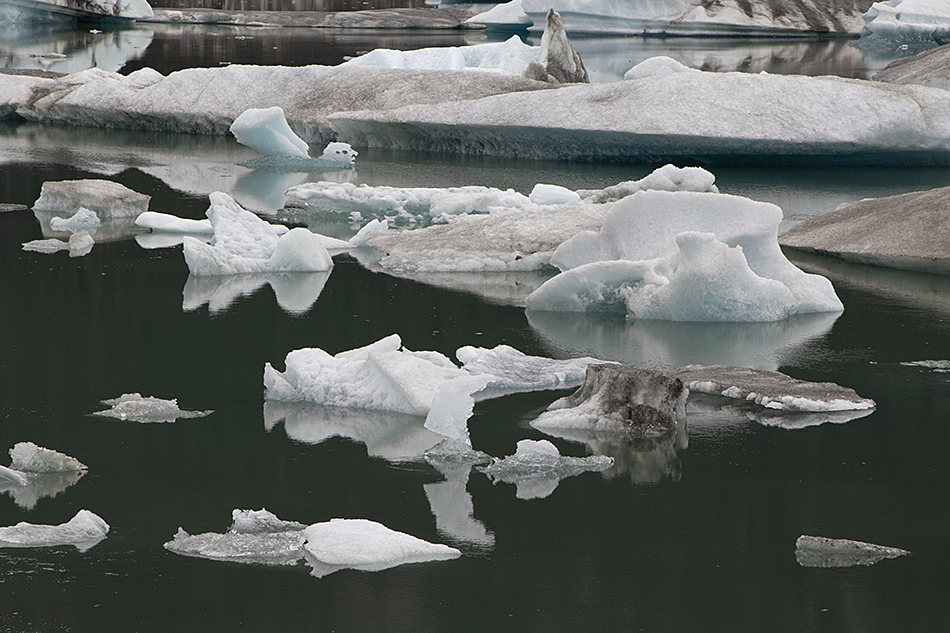
The large lagoon in front of the glacier has a fascinating array of icebergs – many shapes and colours. Photo: © Alan Burger
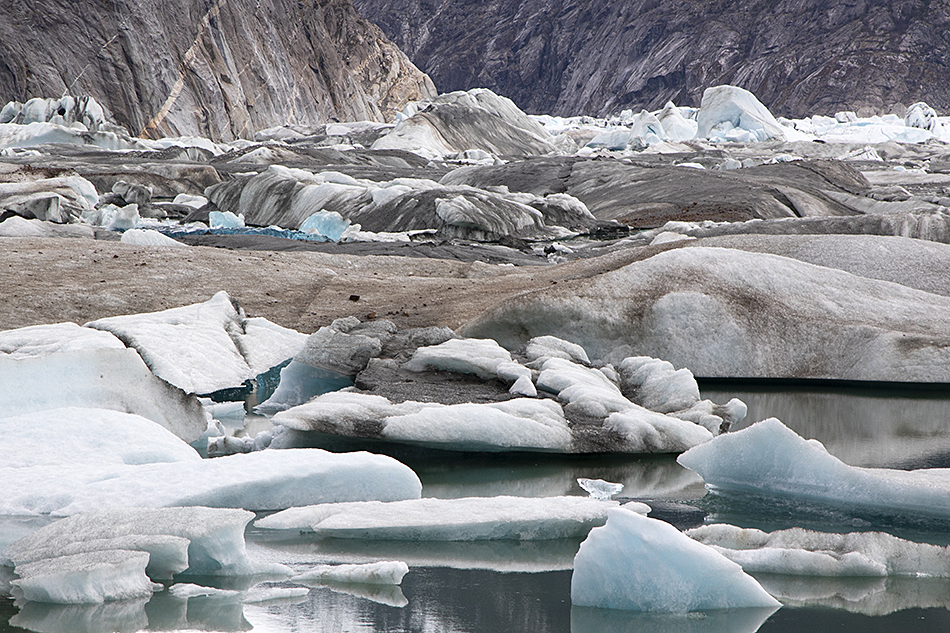
More colourful icebergs in the Baird Glacier lagoon. Photo: © Alan Burger
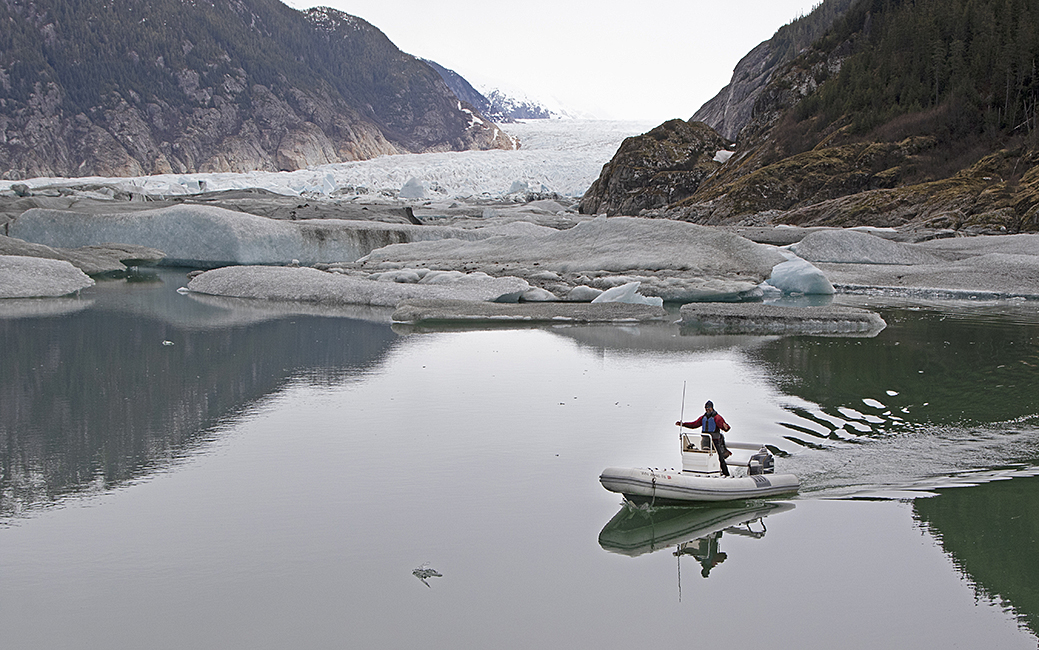
Captain Hans fulfilled a long-held dream of being able to drive the skiff right up into the glacial lagoon. Then we all went on a victory tour of the lagoon.
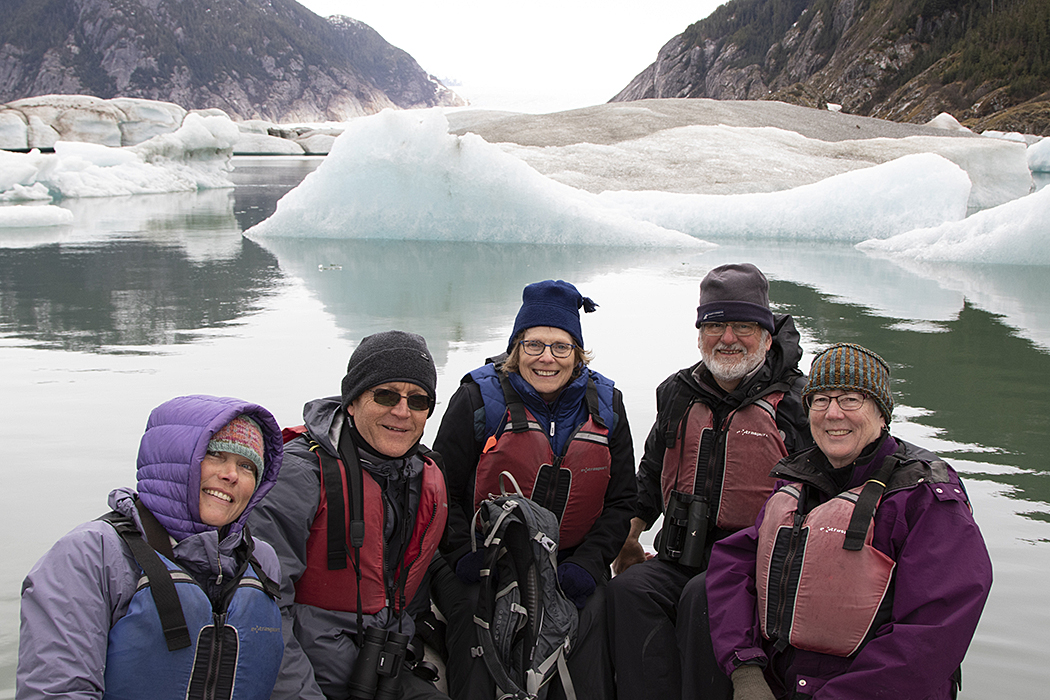
A happy bunch of boaters in the Baird Glacier lagoon, 23 April 2022.
On the 24th April we explored parts of northern Kuiu Island. Here we found many Marbled Murrelets and dozens of Sea Otters. The otters are rapidly increasing in numbers and expanding their range – much to the delight of visiting naturalists and the despair of local crab fishers.
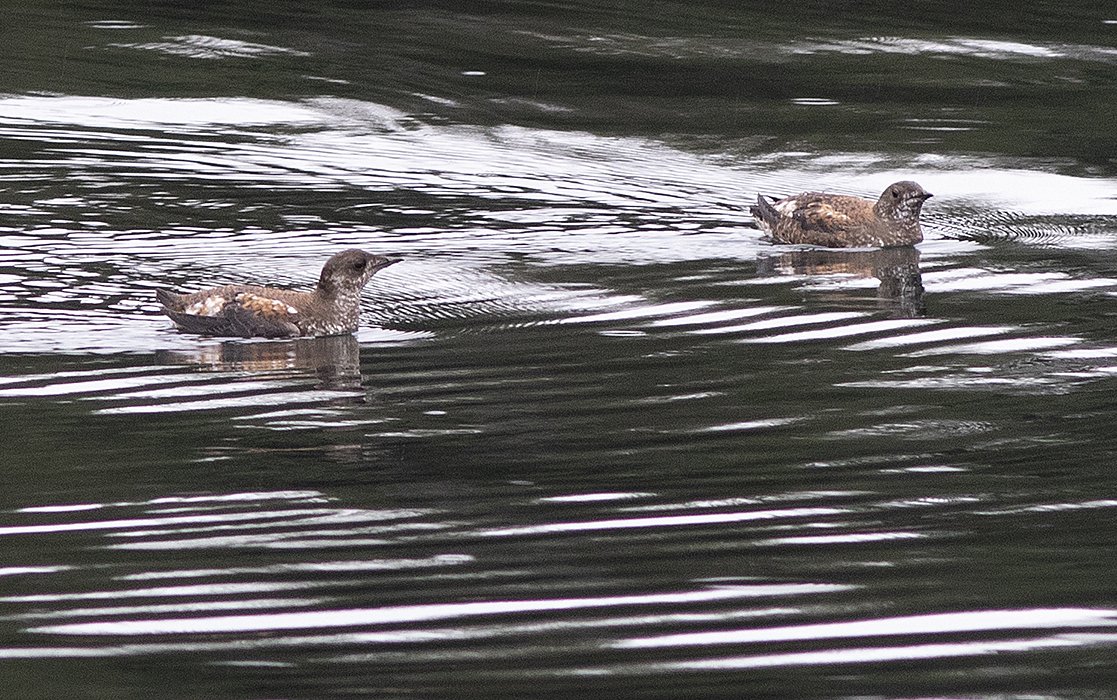
Most of the Marbled Murrelets that we encountered in southeast Alaska were in pairs, preparing to breed. Getting good photos of these birds is tricky because they avoid boats, even kayaks. Photo: © Alan Burger
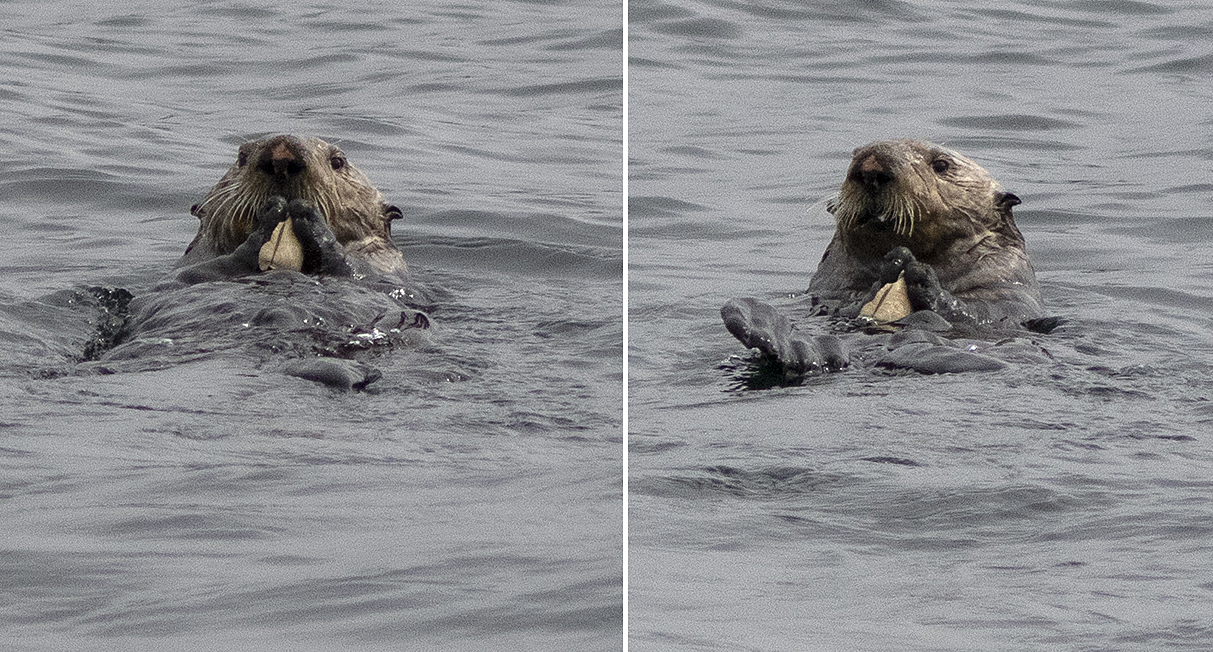
A Sea Otter trying to break into a large clam. At Security Bay on Kuiu Island, 24 April 2022. Photo: © Alan Burger
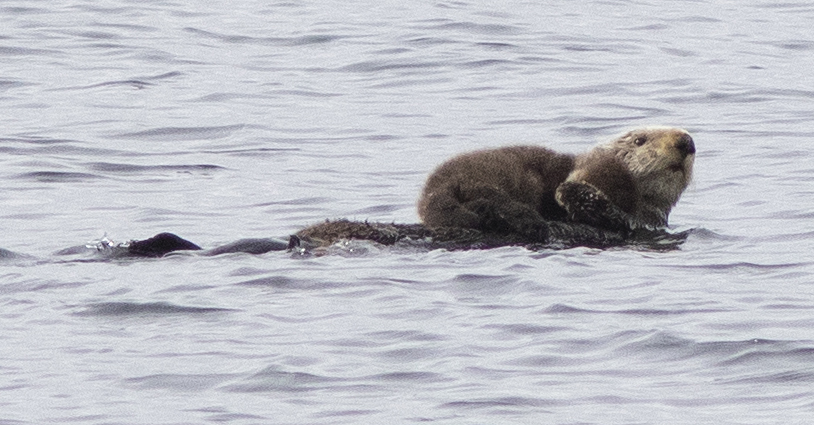
A female Sea Otter with a large pup carried on her chest. The female’s front paw is hiding the baby’s face. Off Kuiu Island, 24 April 2022.
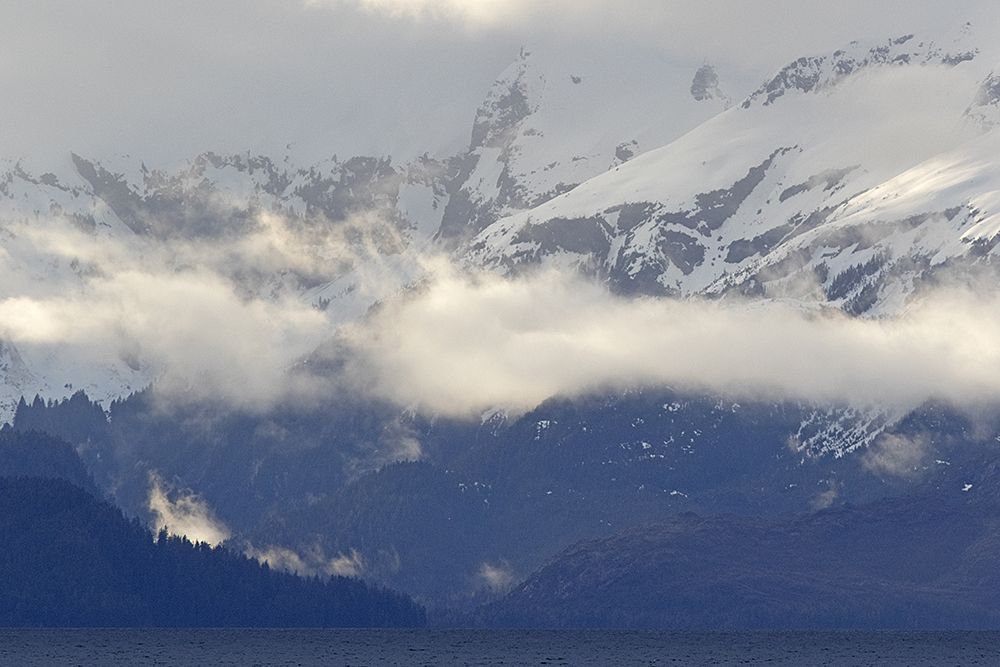
Mountains and mist – Baranof Island seen from Frederick Sound.
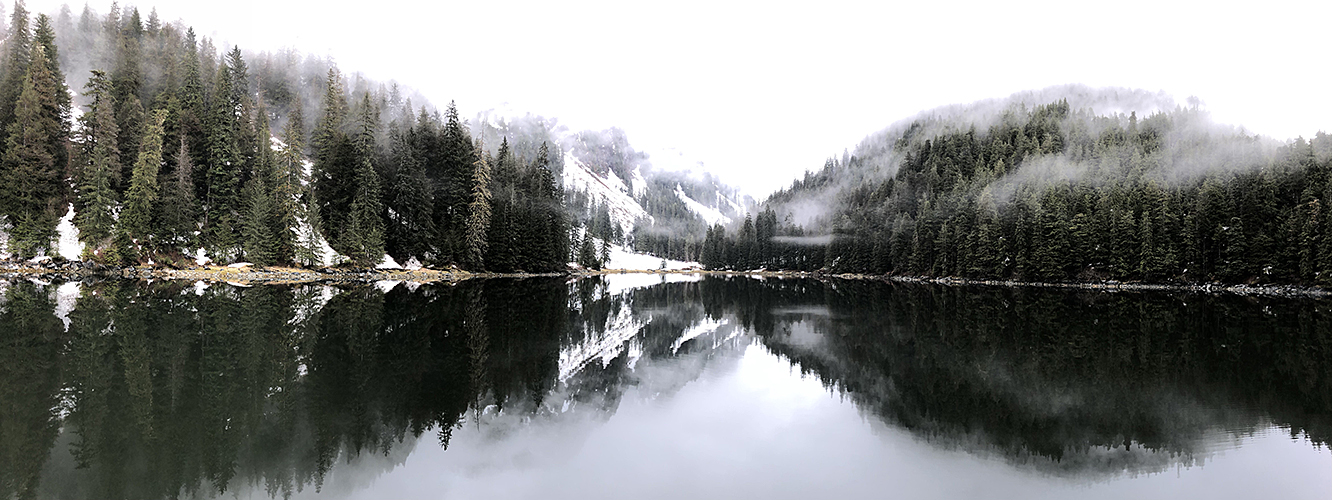
Early morning on 25th April at our anchorage at Baranof Island.
We spent the morning of the 25th exploring Warm Springs Cove on Baranof Island. A handful of recreation cabins and a couple of lodges are huddled along the foreshore, bordered by a thunderous big waterfall. Up the hill are numerous hotsprings and most of the buildings have hot water piped in for heating and for household use. There are also three public hot tubs on the foreshore where one can soak in a stream of hot mineral water – some of us took advantage of this luxury.
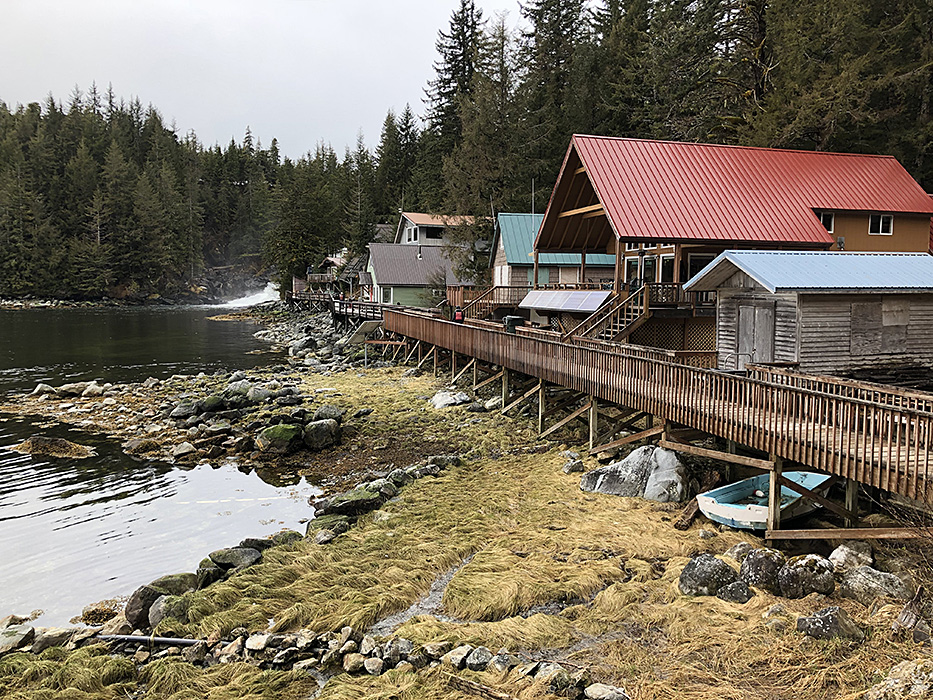
Warm Springs Cove on Baranof Island has an eclectic collection of cabins along the waterfront, and the research station of the Alaska Whale Foundation. Notice the tideline waterfall beyond the buildings.
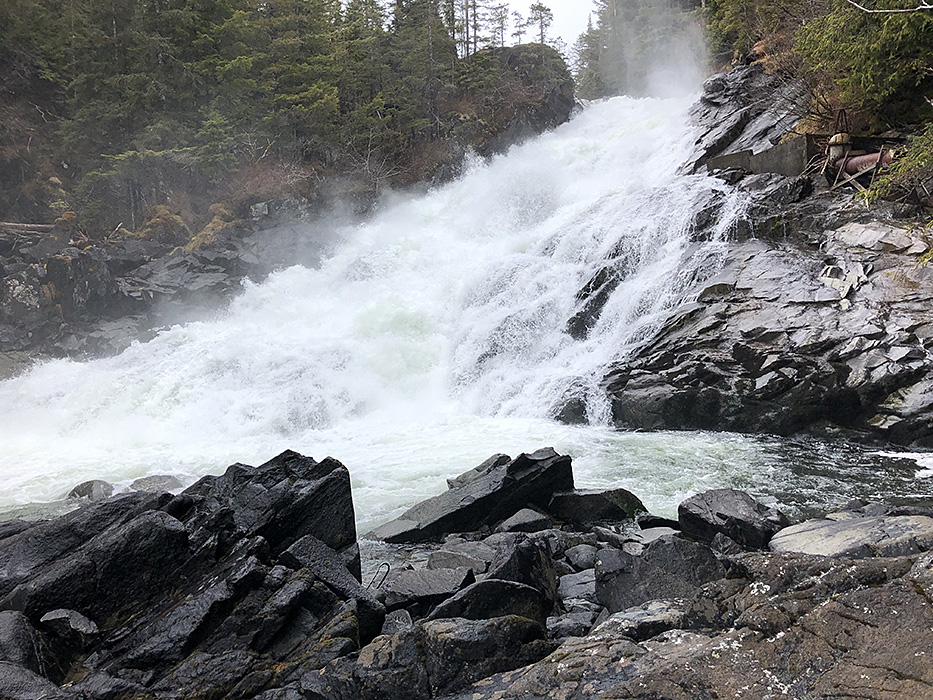
This impressive waterfall borders the shoreline buildings at Warm Springs Cove.
The Alaska Whale Foundation has its research station here and their biologists have undertaken much ground-breaking research on the local humpbacks and other whales. Imagine my surprise to discover that one of the lead researchers is Andy Szabo, who had worked for me as an undergraduate summer student studying Marbled Murrelets on Vancouver Island in 1999. It was great to have a catch-up after more than 20 years.
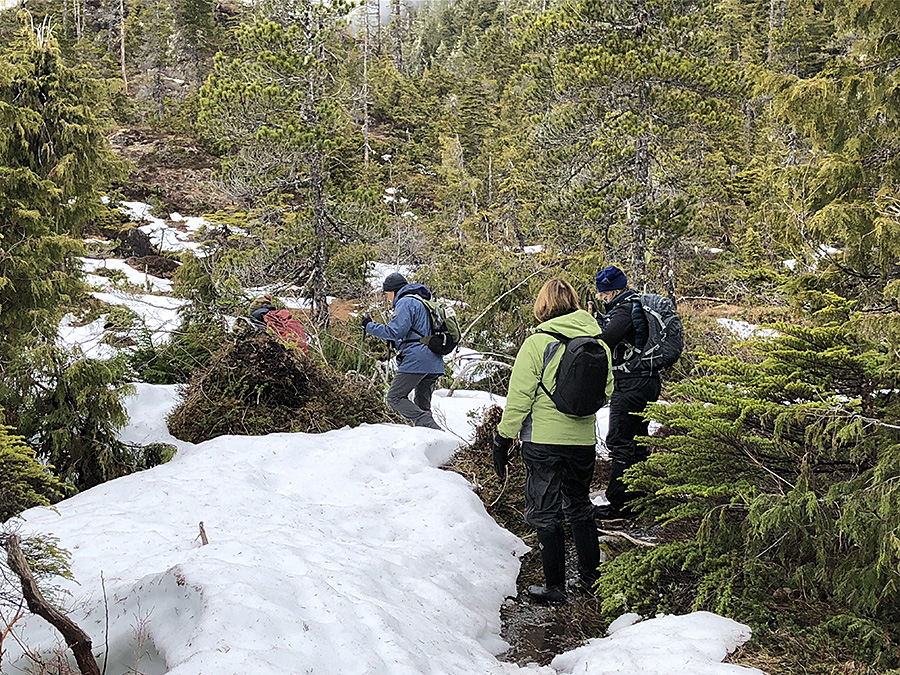
We went for a hike up the hill behind Warm Springs Cove but discovered that spring had not fully arrived here. Deep snow blocked the trail. But much to our surprise, a Rufous Hummingbird was buzzing around this chilly spot.
Based on a tip from Andy Szabo we cruised up the coast of Baranof Island in search of Humpback Whales. And sure enough, an hour or so later we encountered a group of 30-35 humpbacks feeding.
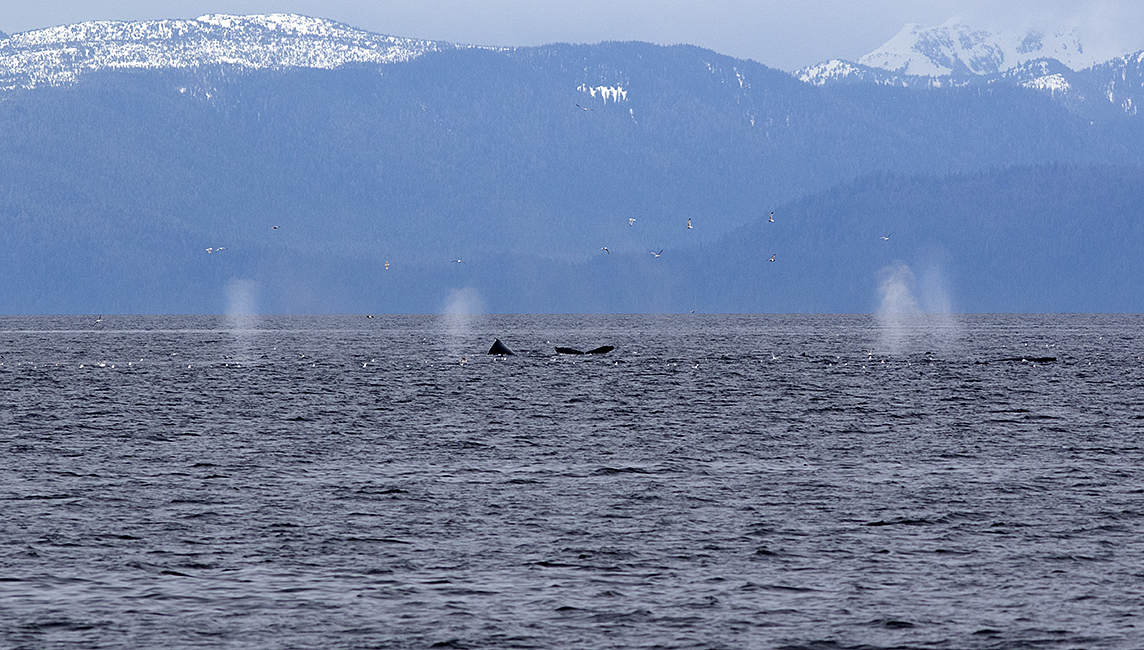
Blows, backs and flukes – even at a distance we could see there was a lot of activity with these Humpback Whales
For the next three hours we drifted along among these huge whales as they performed their unique bubble-net feeding. A couple of whales swim in a circle below a school of small fish – herring in this case – releasing bubbles. The bubbles rise to form a net which startles the fish, keeping them packed in within the bubble net. A male whale then sings below the net which drives the fish upward, trapping them at the surface. At this signal a dozen or more whales surge upward in synchrony and with gaping mouths. Expandable throat pleats allow a humpback to engulf tons of water along with the fish. The water is then forced out through the baleen plates hanging from the whale’s palate. The trapped fish are then swept into the gullet by the whale’s tongue. After a few breathing blows, the whales dive down to repeat the whole process – again and again. It is an amazing spectacle to witness. At times we had two groups of whales doing separate bubble-netting.
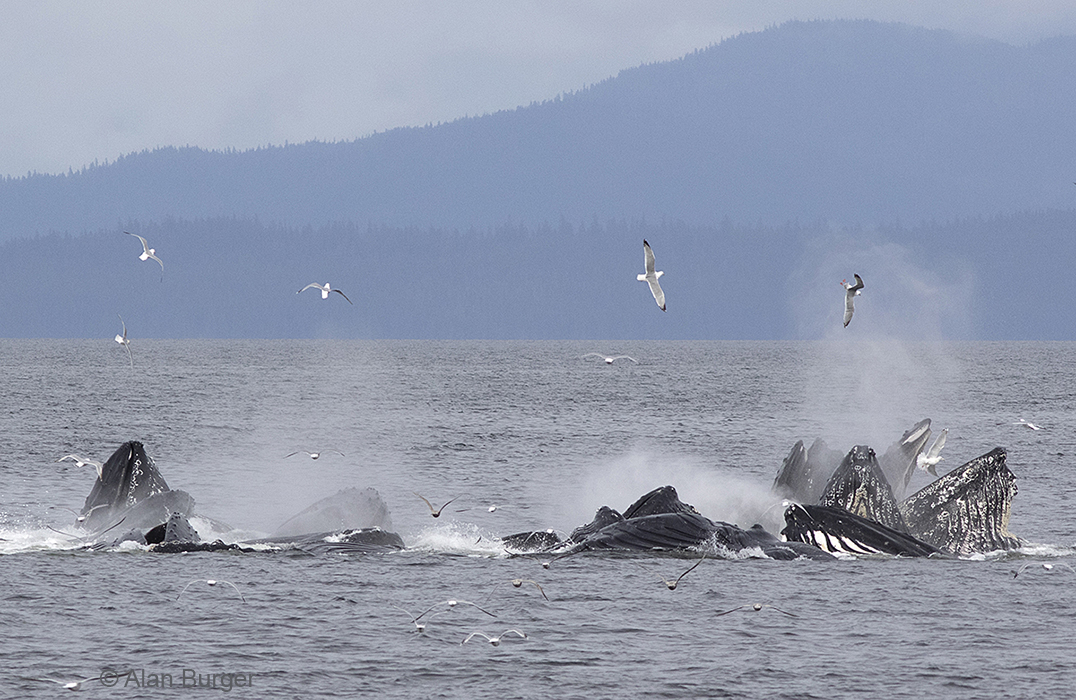
The climax of the bubble-net feeding as 10-15 Humpback Whales rise up in synchrony to engulf the fish at the surface. Photo: © Alan Burger
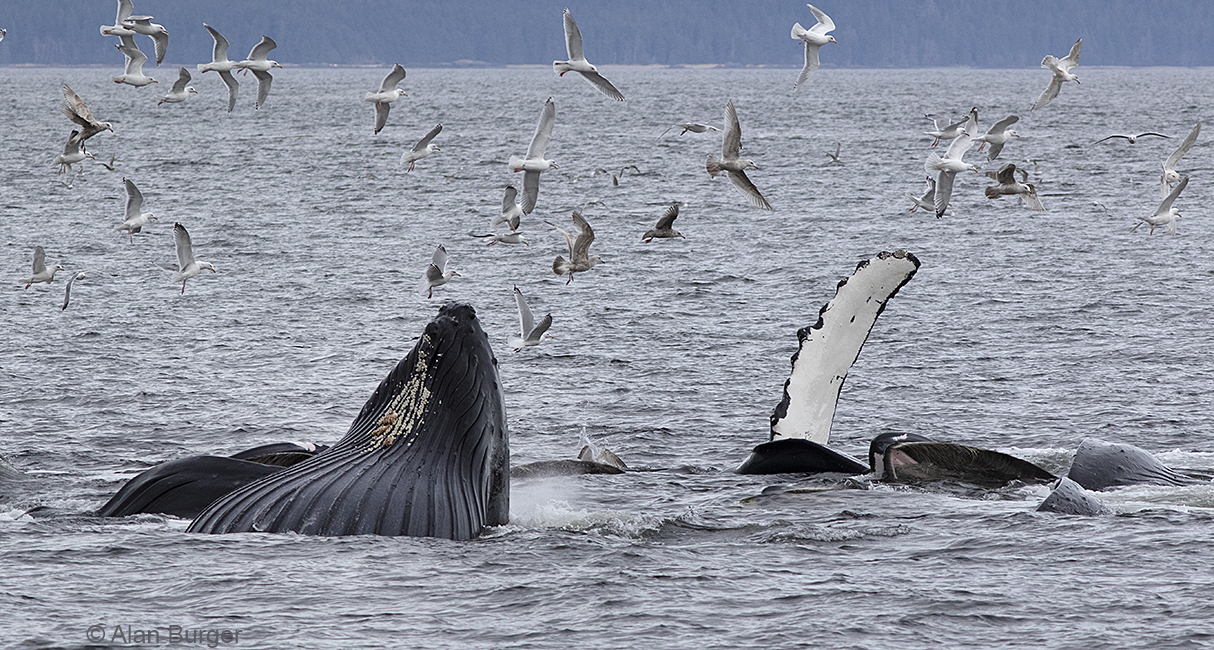
The whale on the left front shows the massive extension of the throat as it engulfs tons of water containing the fish. The white fore-flipper of another whale rises above the surface. Photo: © Alan Burger
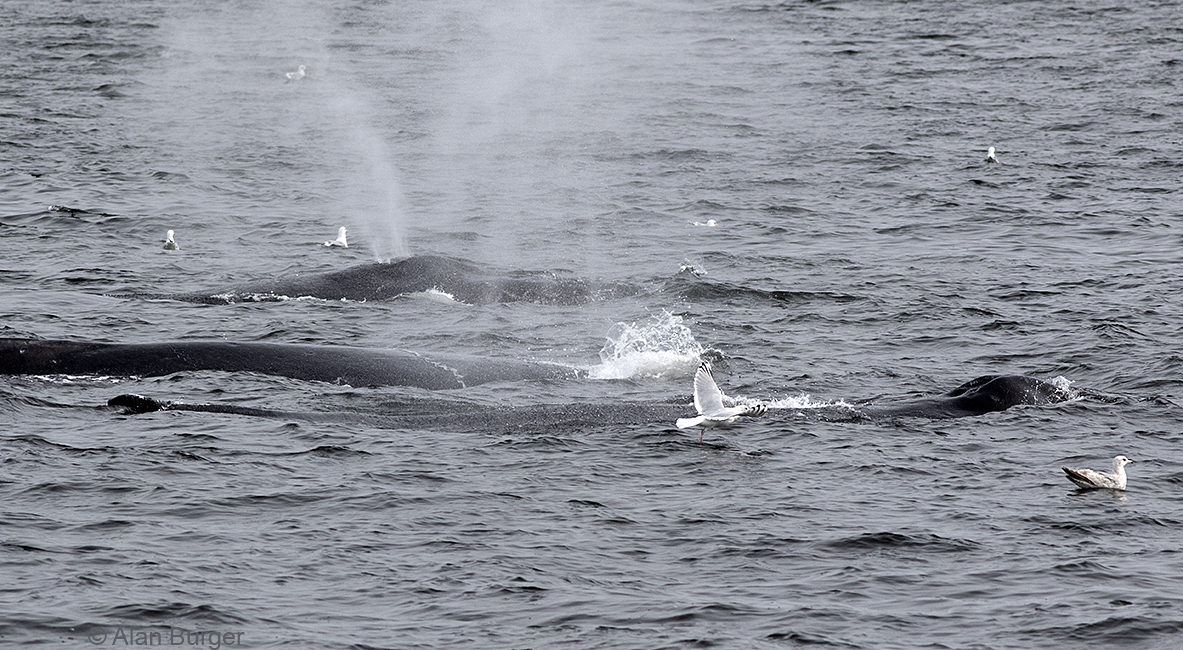
A few blows and breaths for fresh air and the whales dive down to repeat the performance. Photo: © Alan Burger
At one point we shut off the engine and lowered a hydrophone into the water to pick up the sounds the Humpback Whales were making. It was an amazing experience to hear the calls and feeding songs, sometimes painfully loud, at the same time as watching them feed.
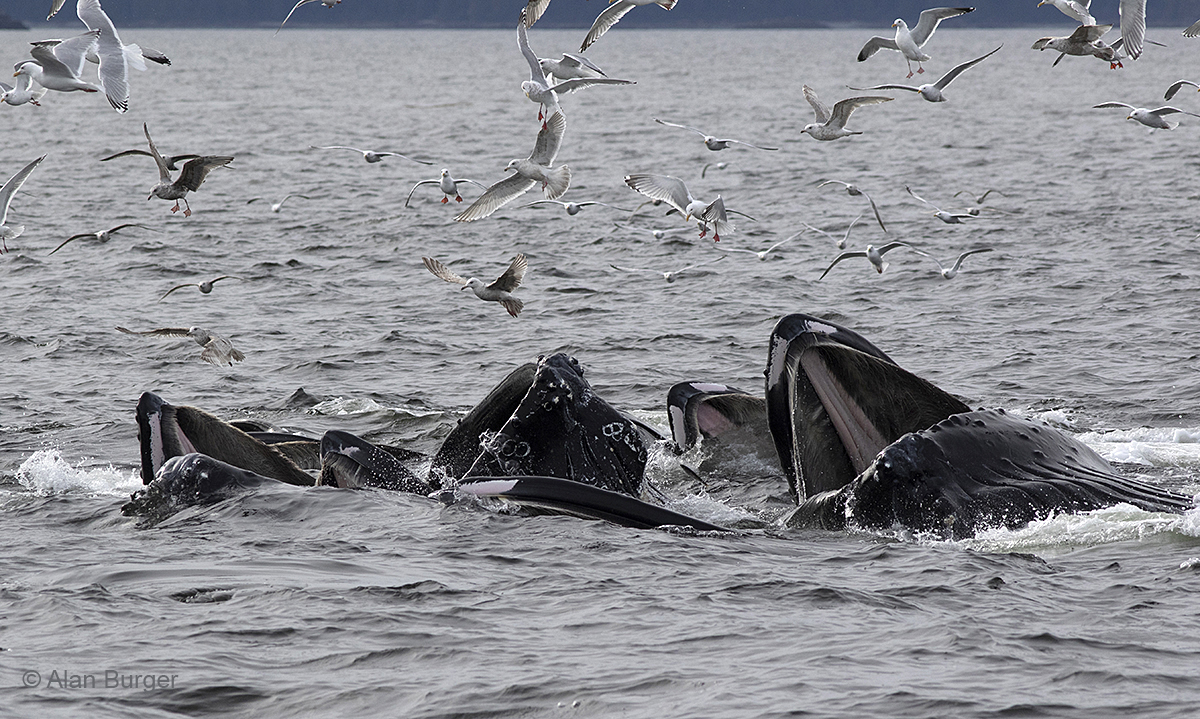
Another feeding event – the pink palate and bristly baleen plates are visible in some whales. Look closely and you can see a herring desperately leaping to escape. Photo: © Alan Burger
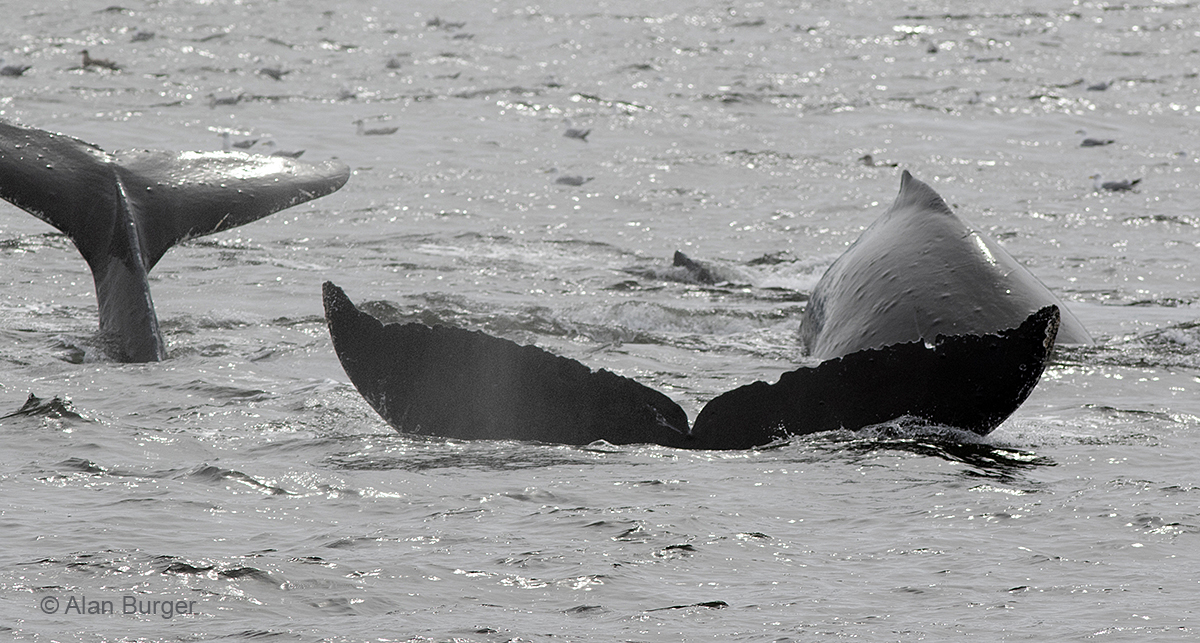
Flukes and humpy backs amidst the mist from their blows as the Humpbacks dive again. Photo: © Alan Burger
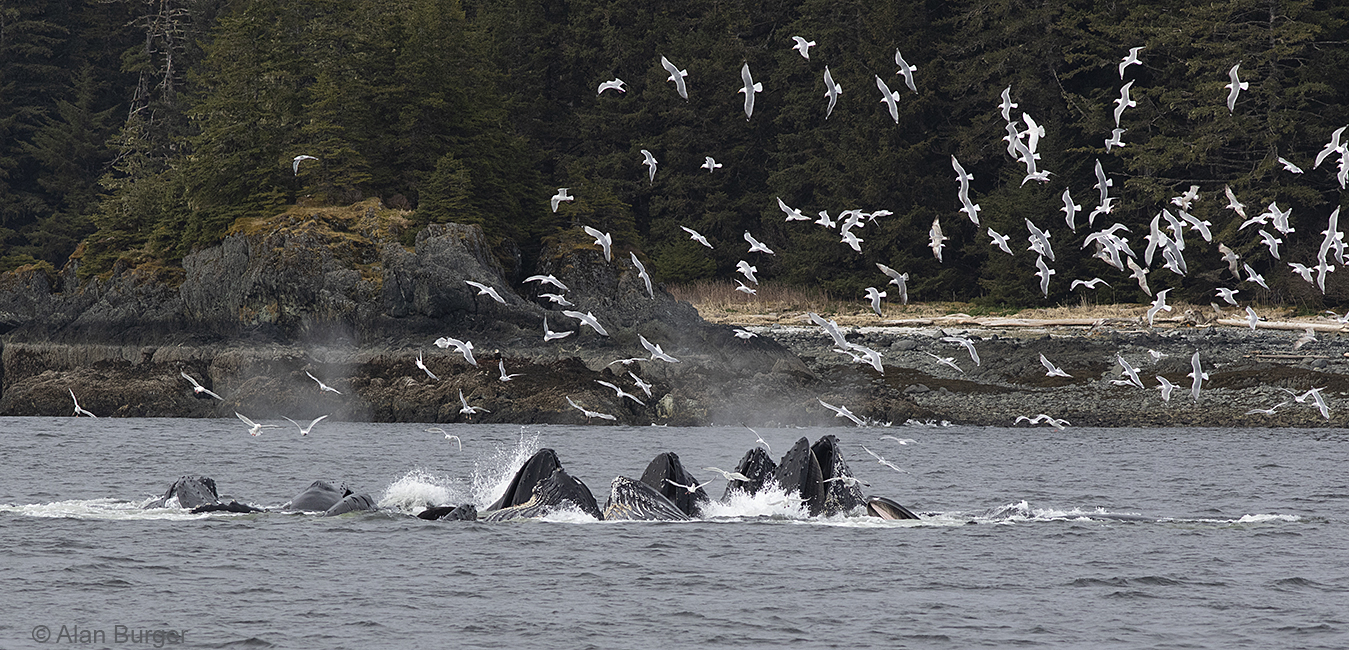
Hundreds of gulls attend the feeding whales and come swarming in hoping to snatch a herring as the whales rise. Appropriately most of them are Herring Gulls. Photo: © Alan Burger
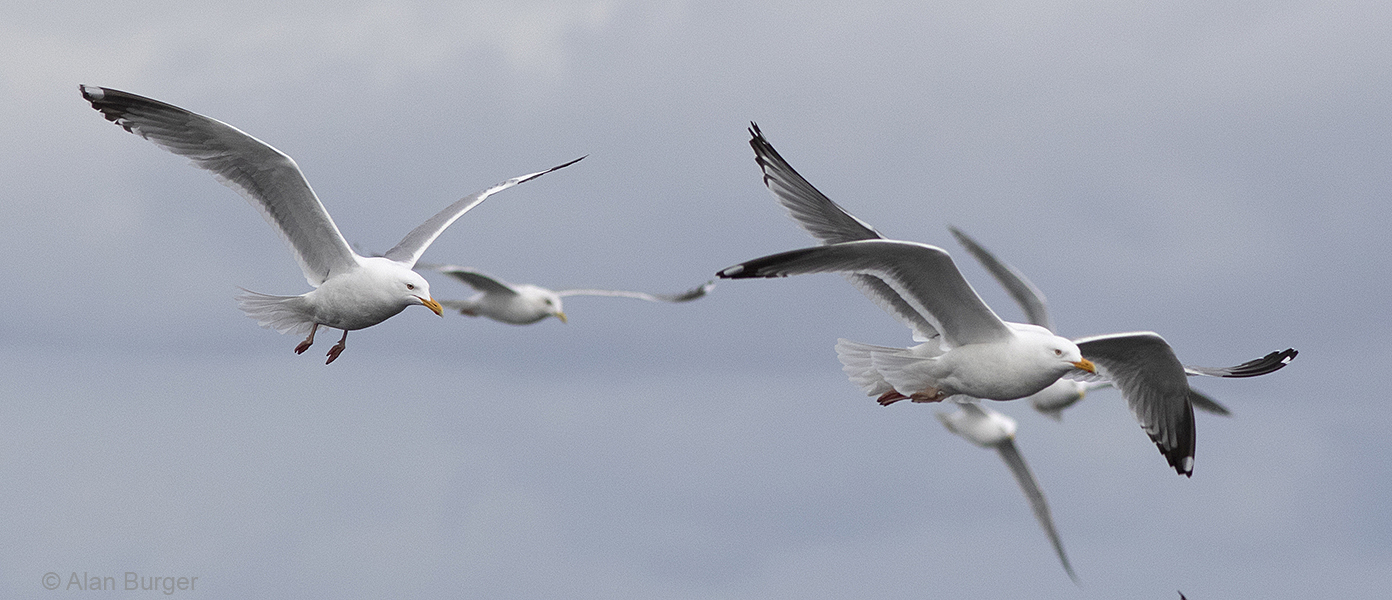
Herring Gulls looking for a meal among the Humpbacks. Photo: © Alan Burger
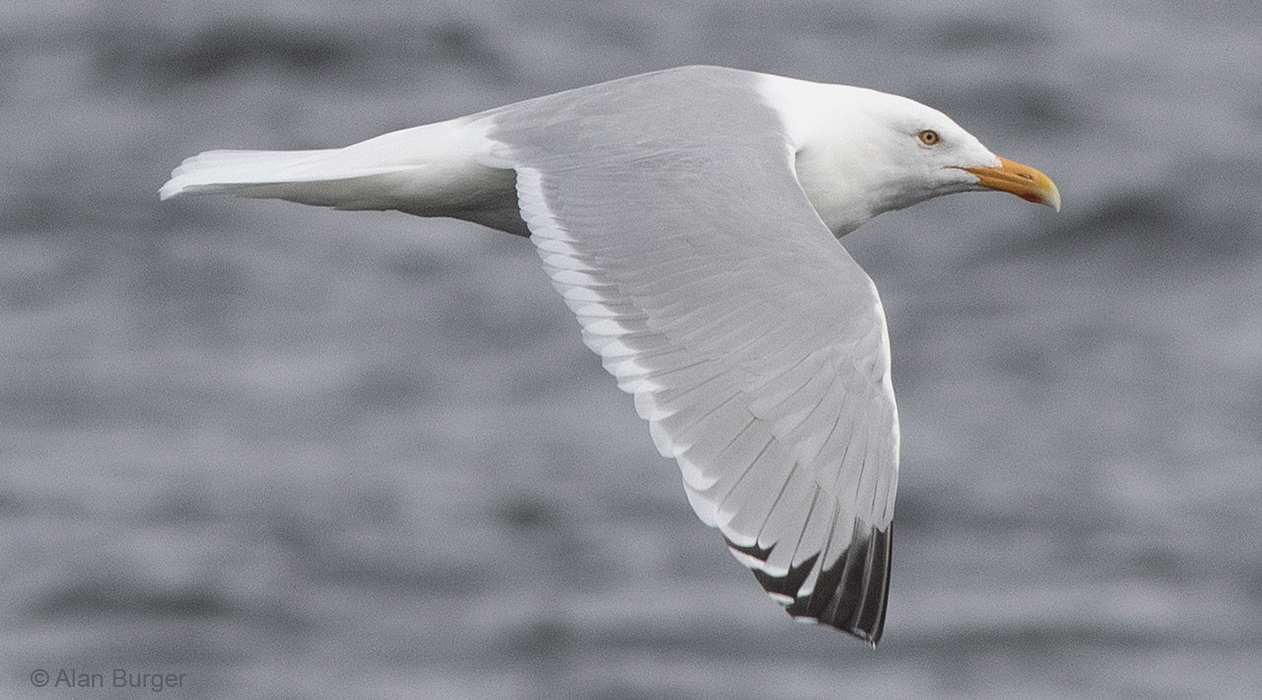
A close-up of an adult Herring Gull. Photo: © Alan Burger
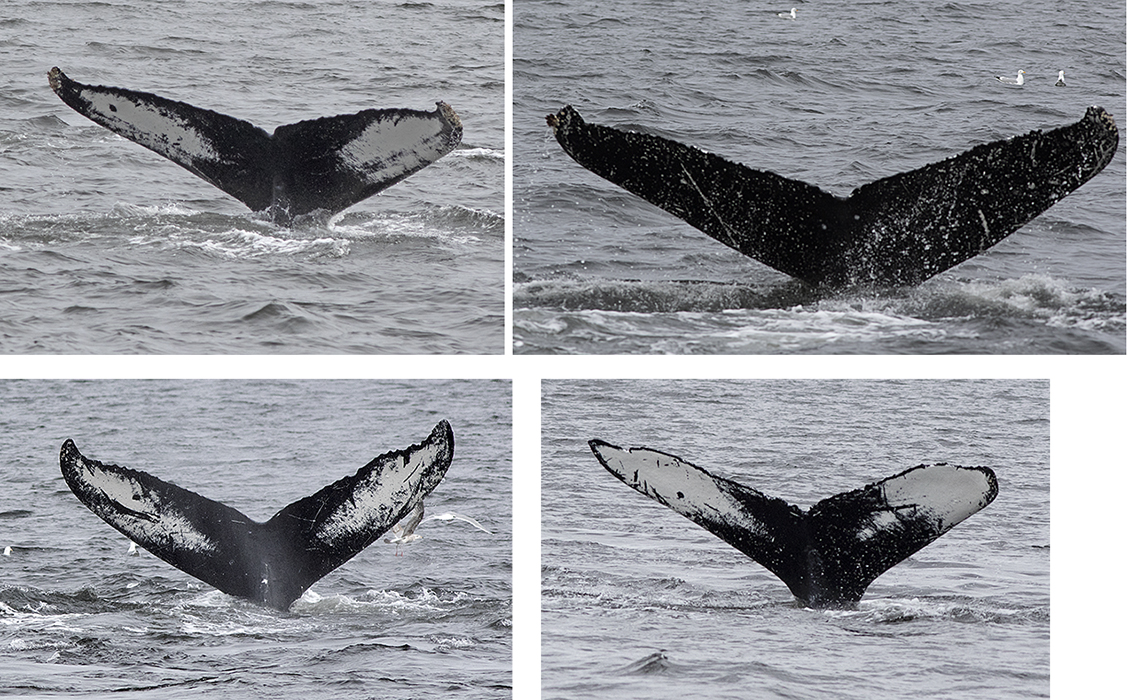
The markings on the underside of a Humpback’s tail are its fingerprint. Biologists can identify individual whales from such photos, and track their movements, breeding and social lives. Photos: © Alan Burger
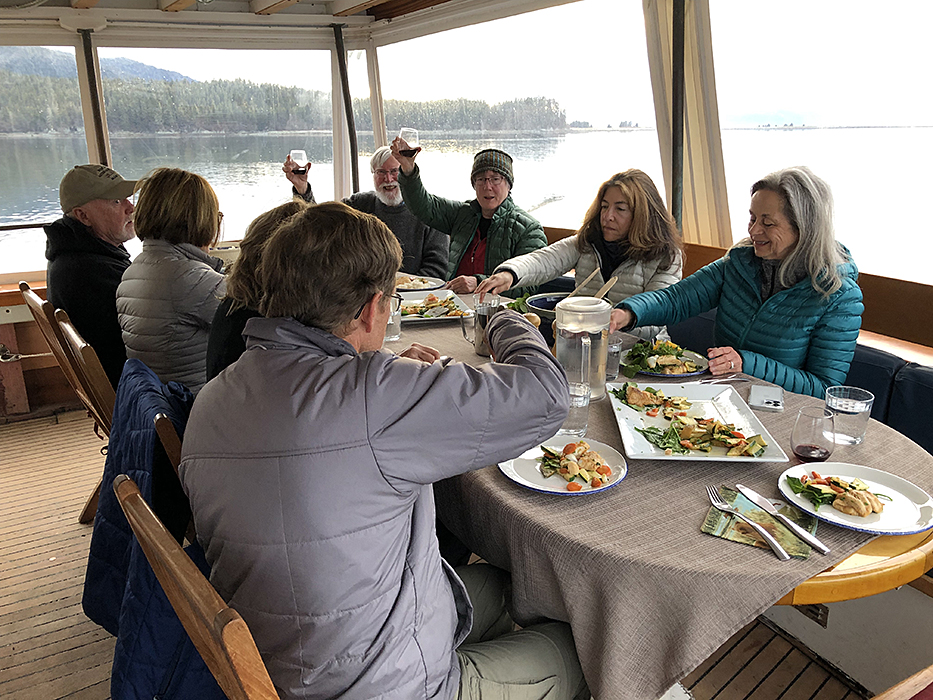
Dinner in the stern fantail of the Sea Wolf. We enjoyed gourmet meals throughout the voyage.
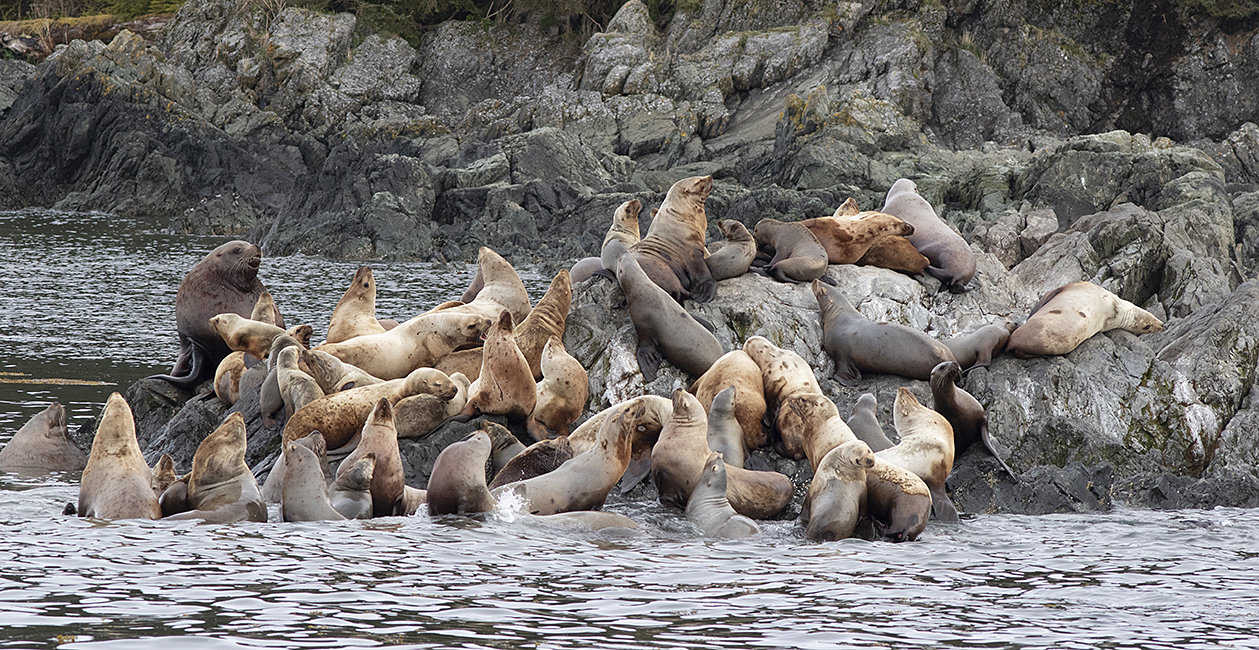
A popular haulout for Steller’s Sea Lions at the Brothers Islands. These are mostly immature males. Photo: © Alan Burger
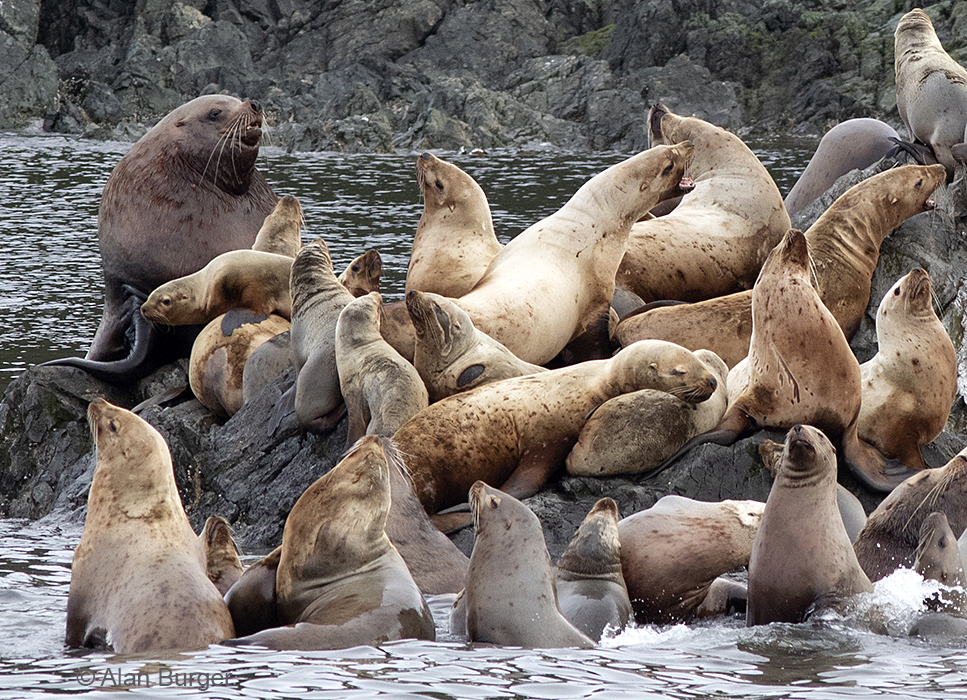
Steller’s Sea Lions are the largest of the eared seals (Otaridae). Big males, like the one on the left can weigh over 1,000 kg. Photo: © Alan Burger
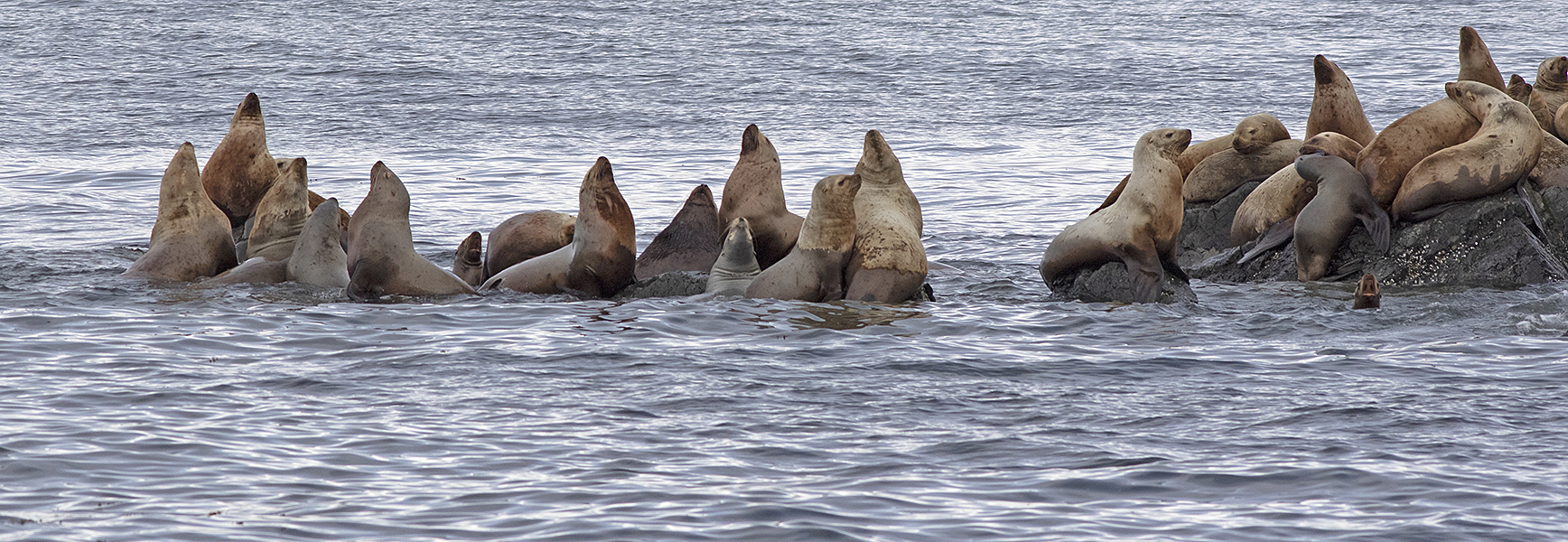
Steller’s Sea Lions at the Brothers Islands. Photo: © Alan Burger
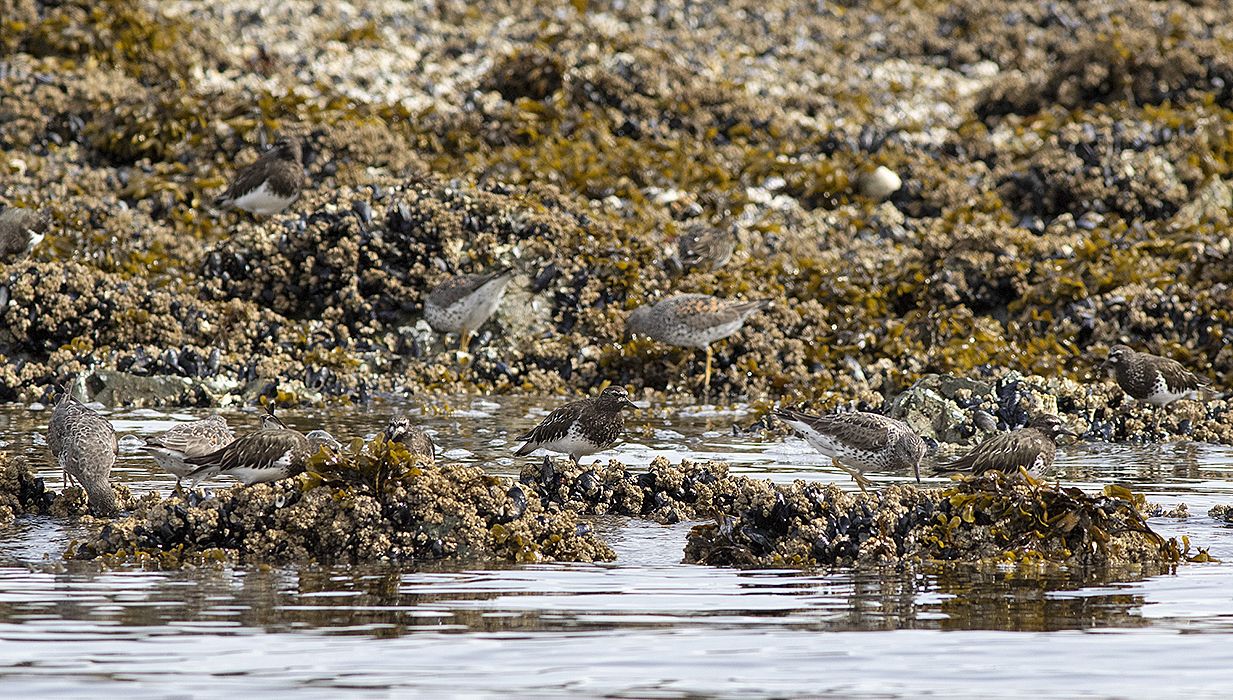
The productive intertidal zone in southeast Alaska provides rich foraging for many shorebirds – here we have Surfbirds and Black Turnstones. Photo: © Alan Burger
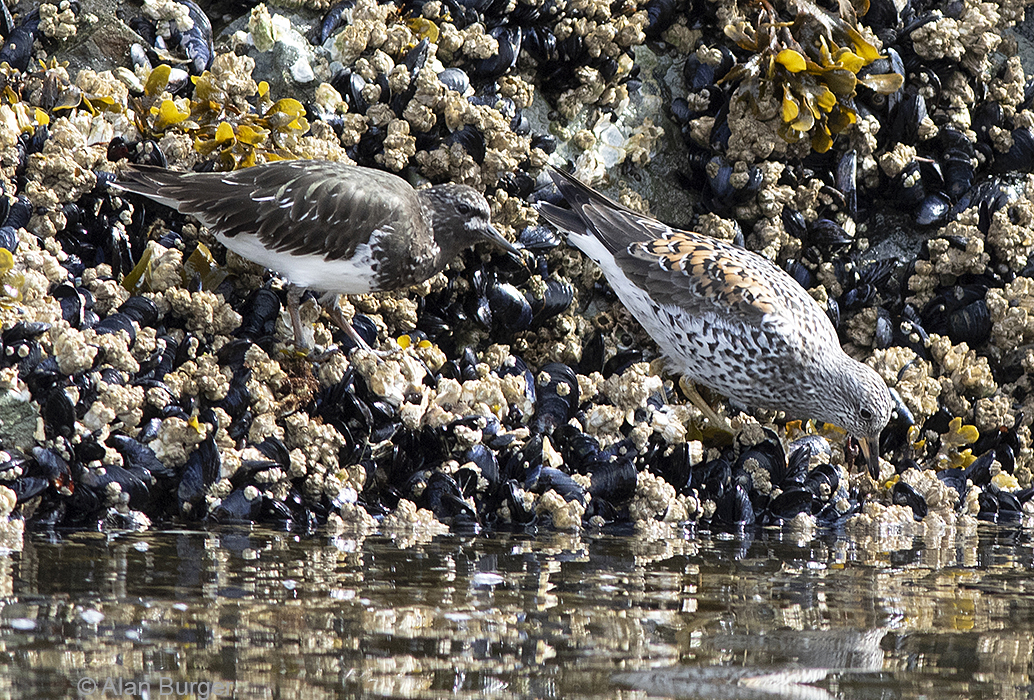
Black Turnstone on the left and Surfbird, right. Photo: © Alan Burger
Just as the 25th April belonged to Humpback Whales, the 26th belonged to Orcas (Killer Whales). Early in the afternoon in calm sea we could see some black fins a long way off and as we got closer we could see a dozen or more Orcas coming our way. They were evidently not in a hurry to move along and for over an hour they swam and played near our little ship, sometimes passing within a few metres.
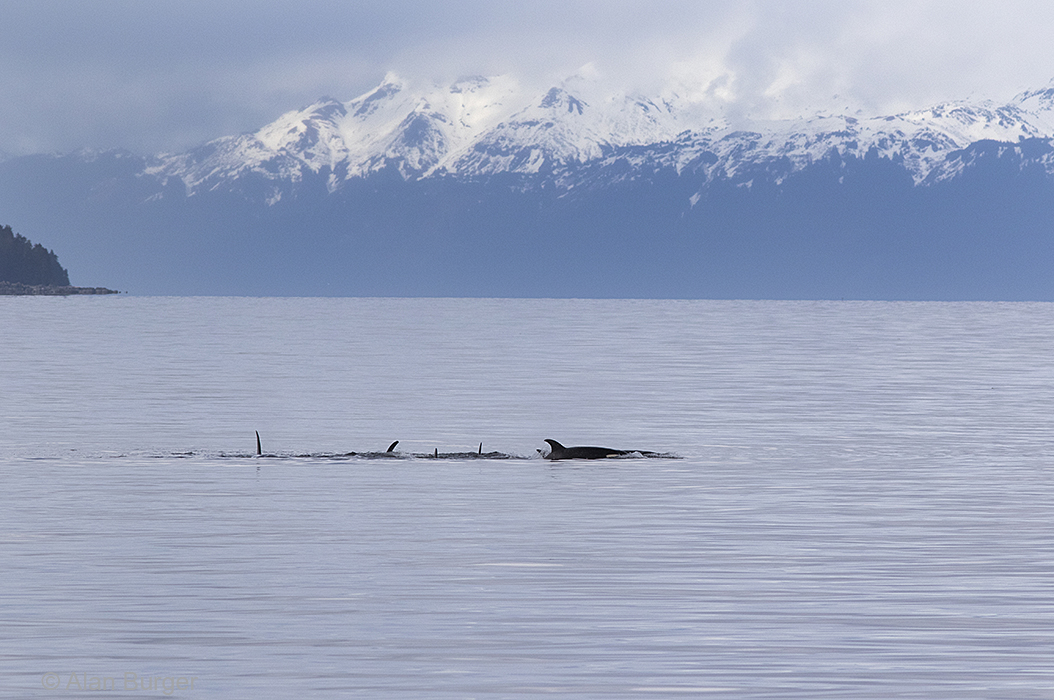
The tall dorsal fins of Orcas (Killer Whales) make them visible a long way off, especially in calm seas. 26 April 2022. Photo: © Alan Burger
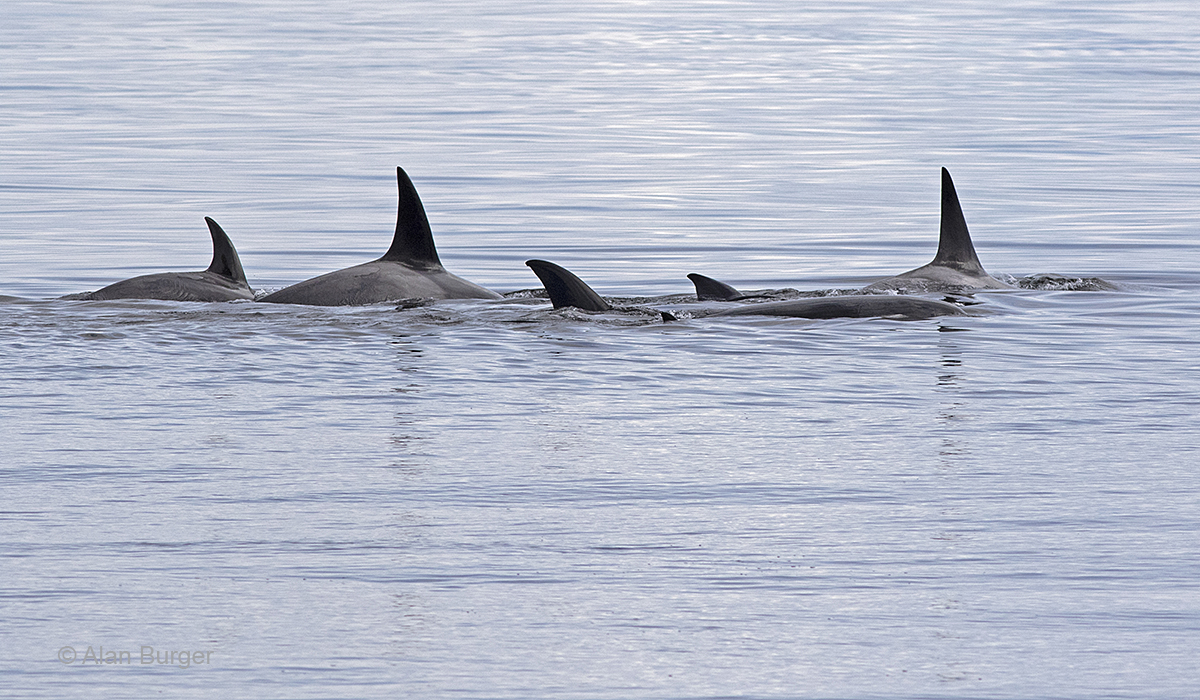
The pod we encountered had Orcas of all ages. Photo: © Alan Burger
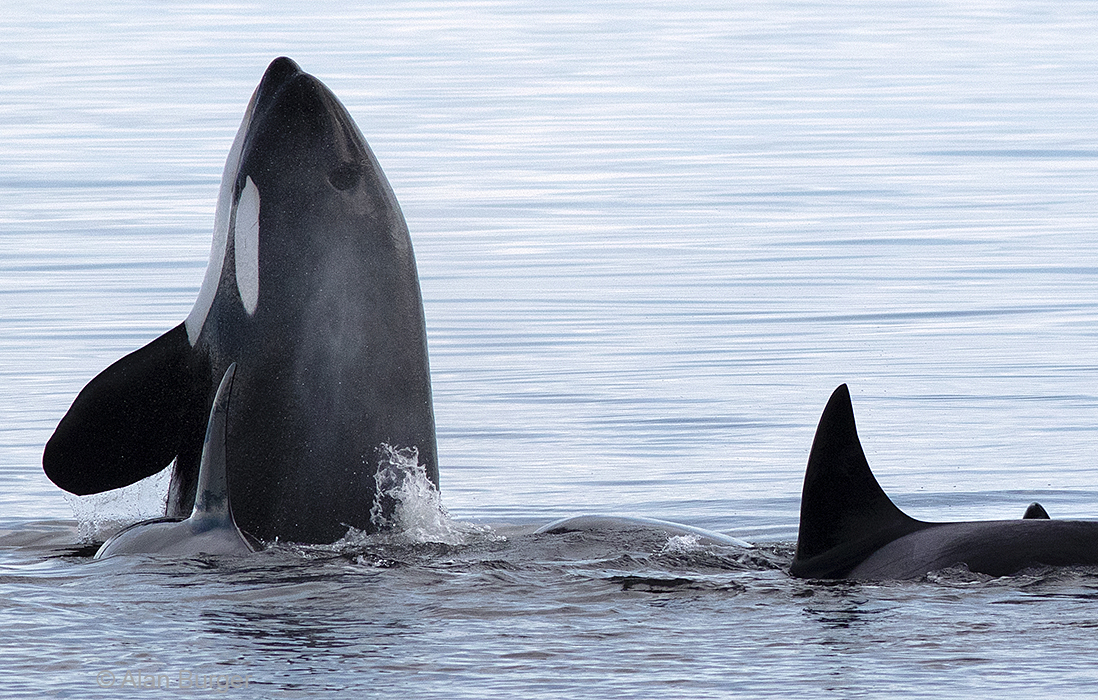
A spyhopping Orca. Photo: © Alan Burger
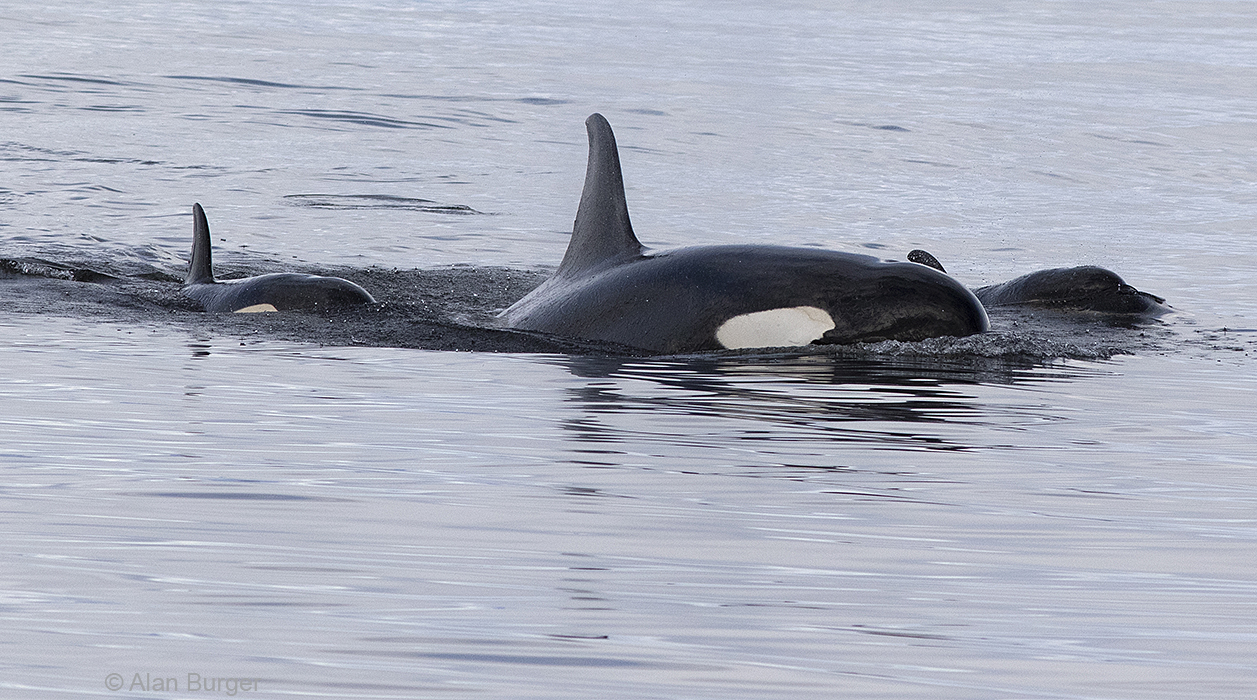
This female was accompanied by two calves – one a year or more old and the smaller one a more recent addition. Photo: © Alan Burger
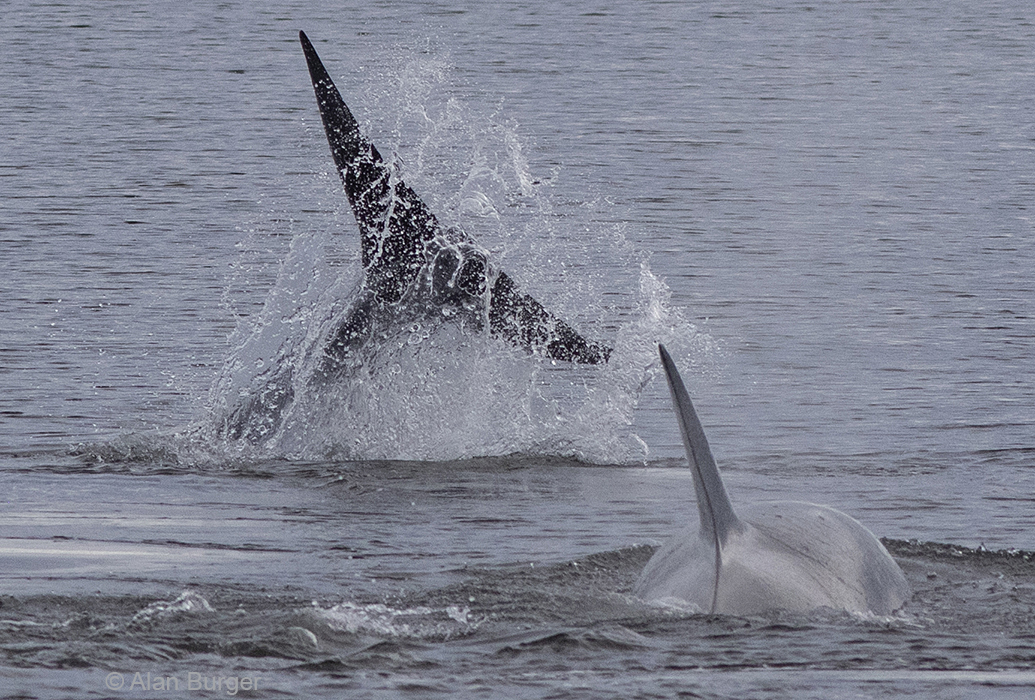
Tail-slapping – just playfulness or a social signal of some sort? Photo: © Alan Burger
Once again, we shut off the engine and lowered the hydrophone into the water. More magic as we listened to all the squeaks and trills as the Orcas passed by, leaving us to imagine what this communication was all about.
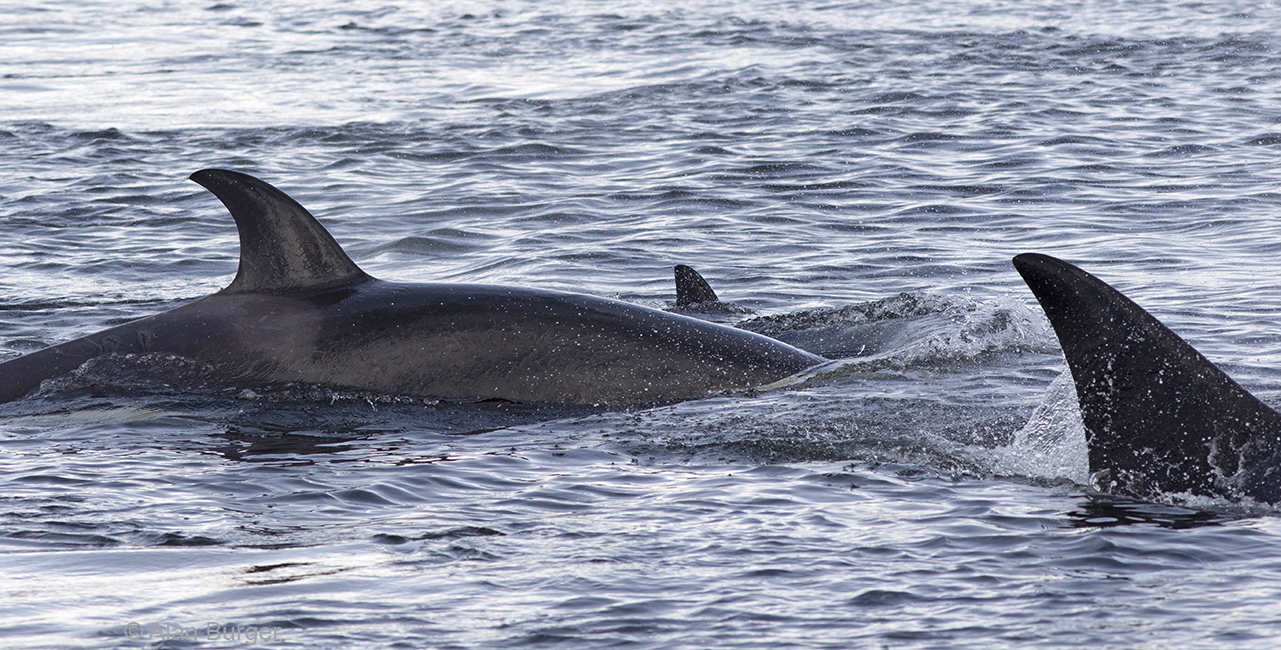
Orcas passing close by the vessel. Photo: © Alan Burger
Our final full day of the voyage was spent in Endicott Arm – a long, narrow fjord with Dawes Glacier at its head. Long before we could see the glacier we were encountering chunks of ice – mostly bergy bits the size of a car or bus and later some reasonable icebergs.
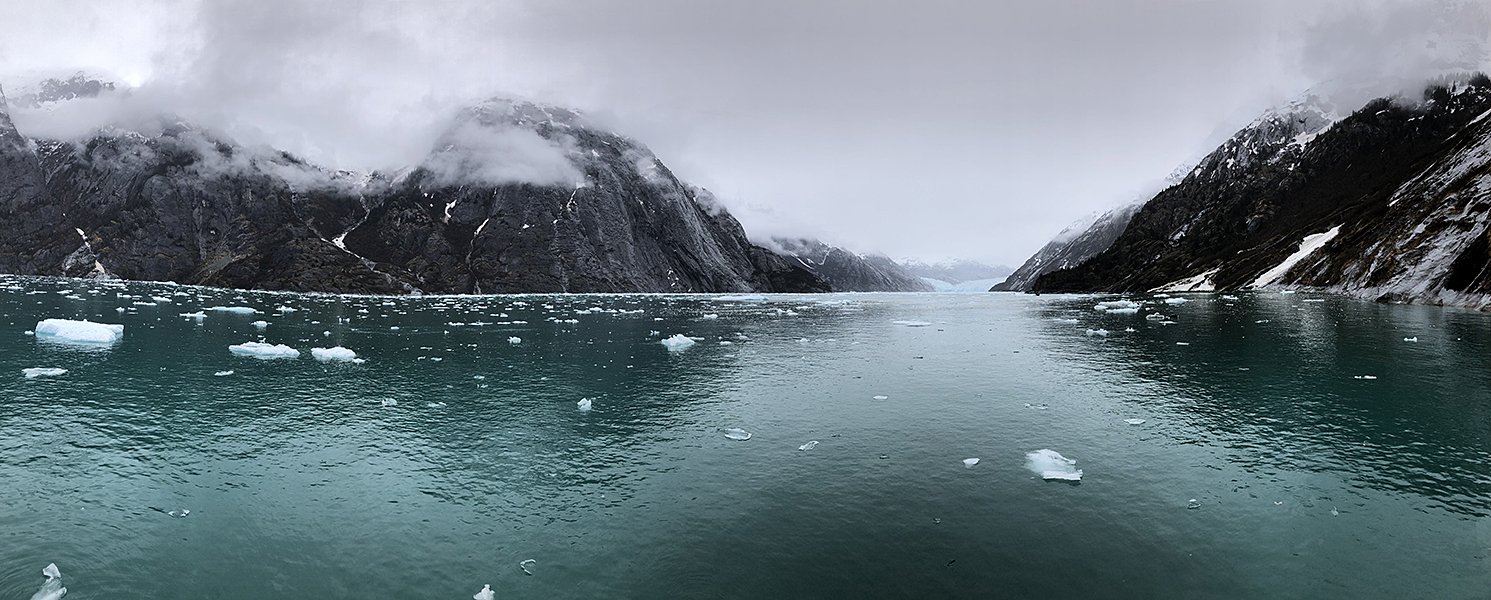
Approaching the Dawes Glacier in Endicott Arm – 27 April 2022. Photo: © Alan Burger
Captain Hans took the Sea Wolf a long way up through the icy water until we were just a km or two from the glacier front. Then we launched the kayaks and went paddling among the icebergs, bergy bits and growlers. A wonderful experience.
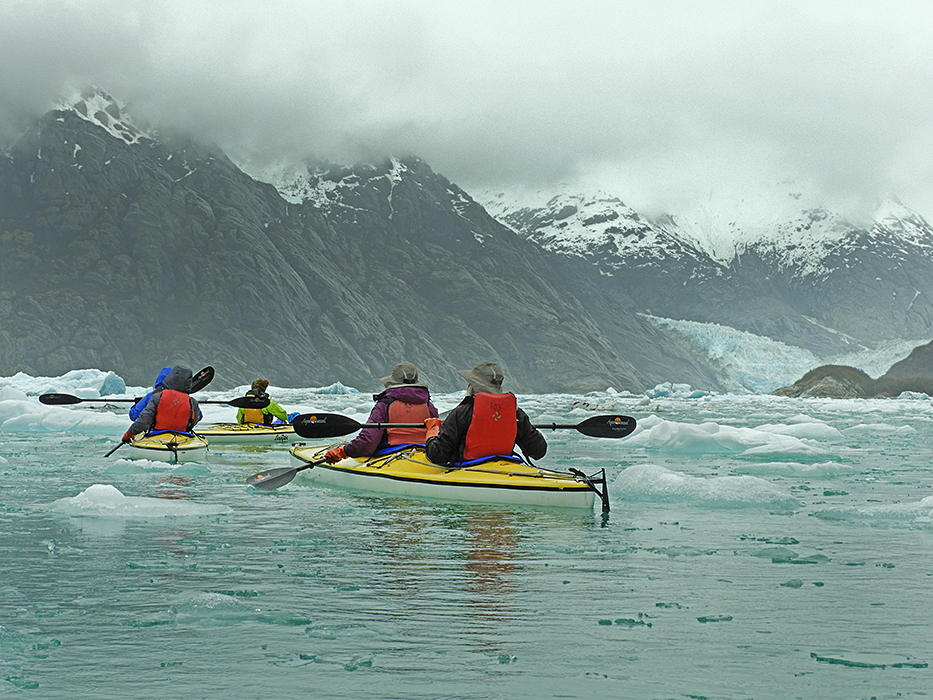
Kayaking in the icy waters in front of the Dawes Glacier, Endicott Arm. Photo: © Alan Burger
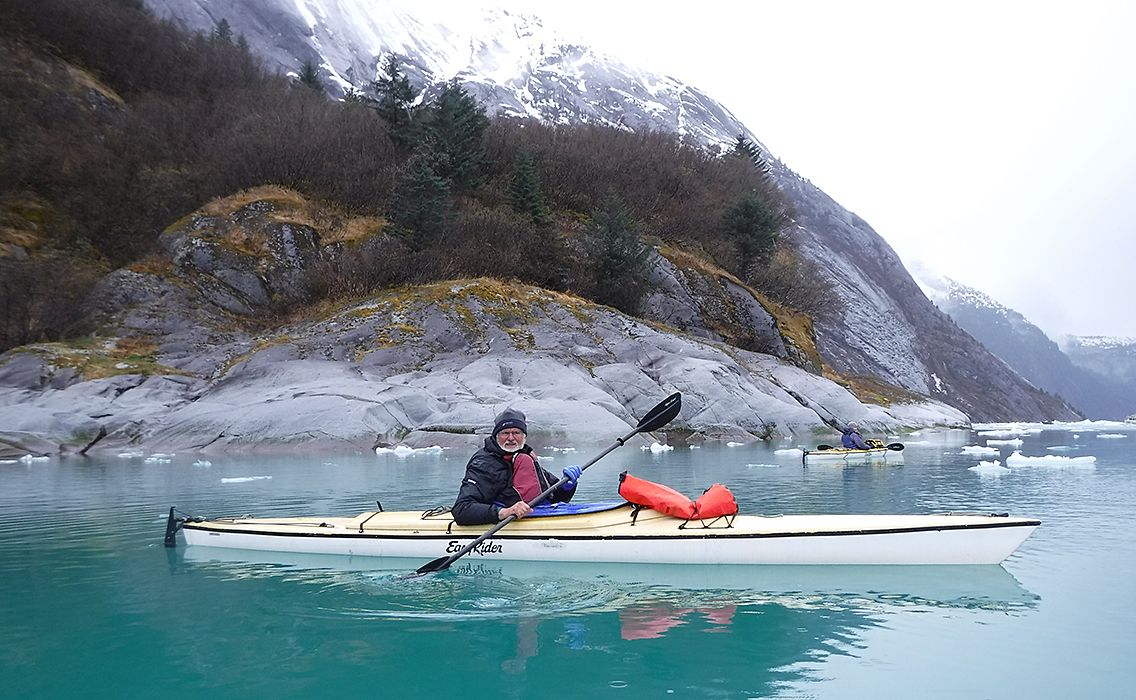
Alan kayaking at the Dawes Glacier, 27 Spril 2022. Photo: Dick & Marjy Fiddler
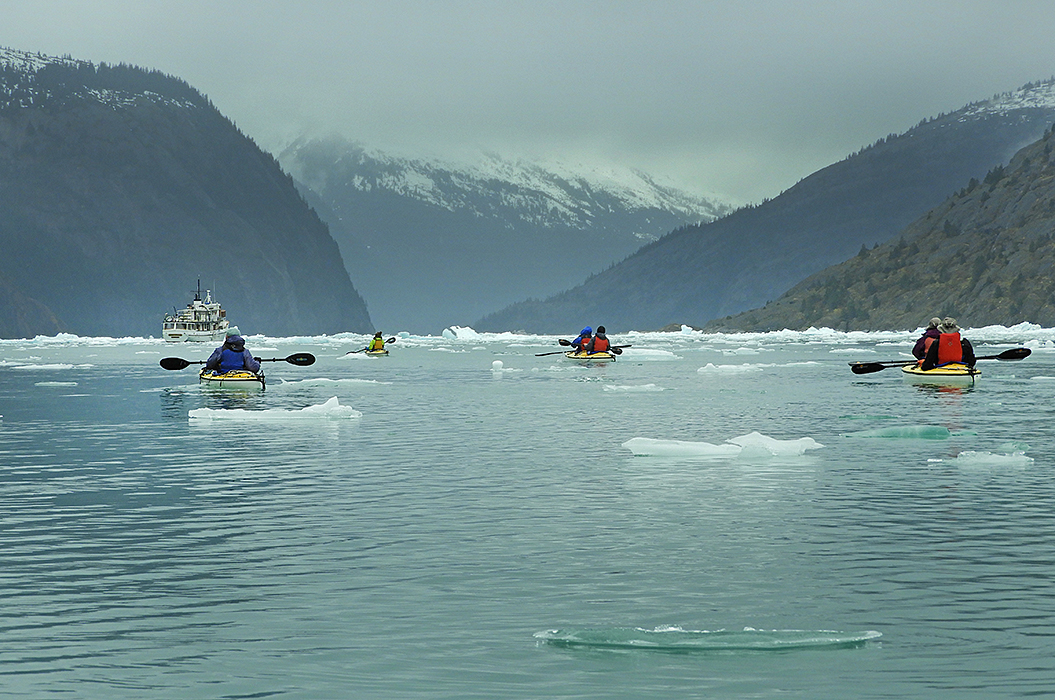
Returning to the Sea Wolf at the Dawes Glacier.
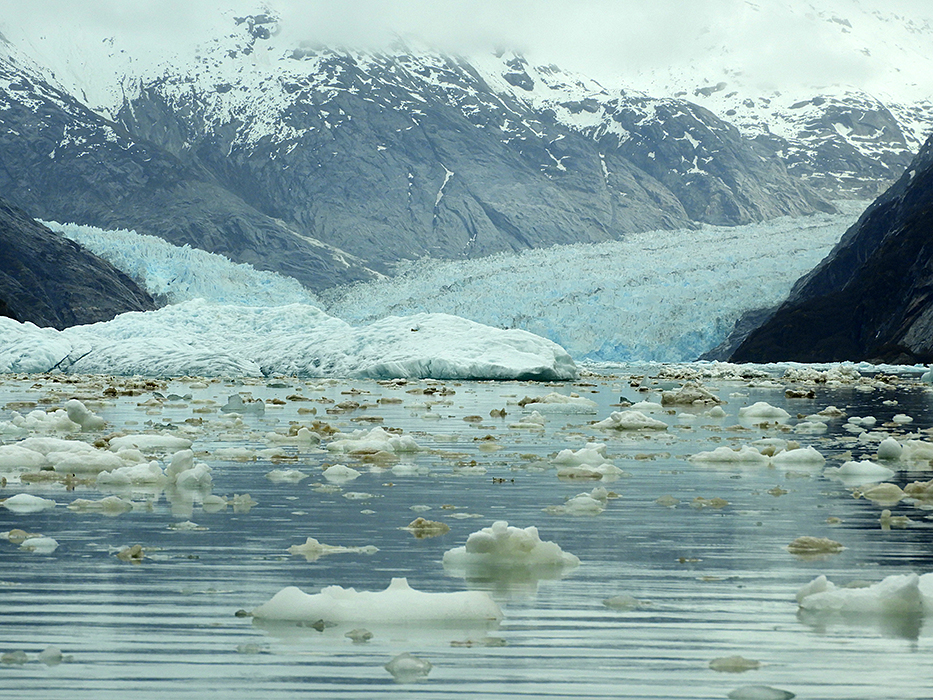
A sea level view of the Dawes Glacier. Like most Alaskan glaciers, this one is retreating rapidly. The rock face most recently exposed by the disappearing ice shows up as pale and un-vegetated on the far side of the glacier. Photo: © Alan Burger
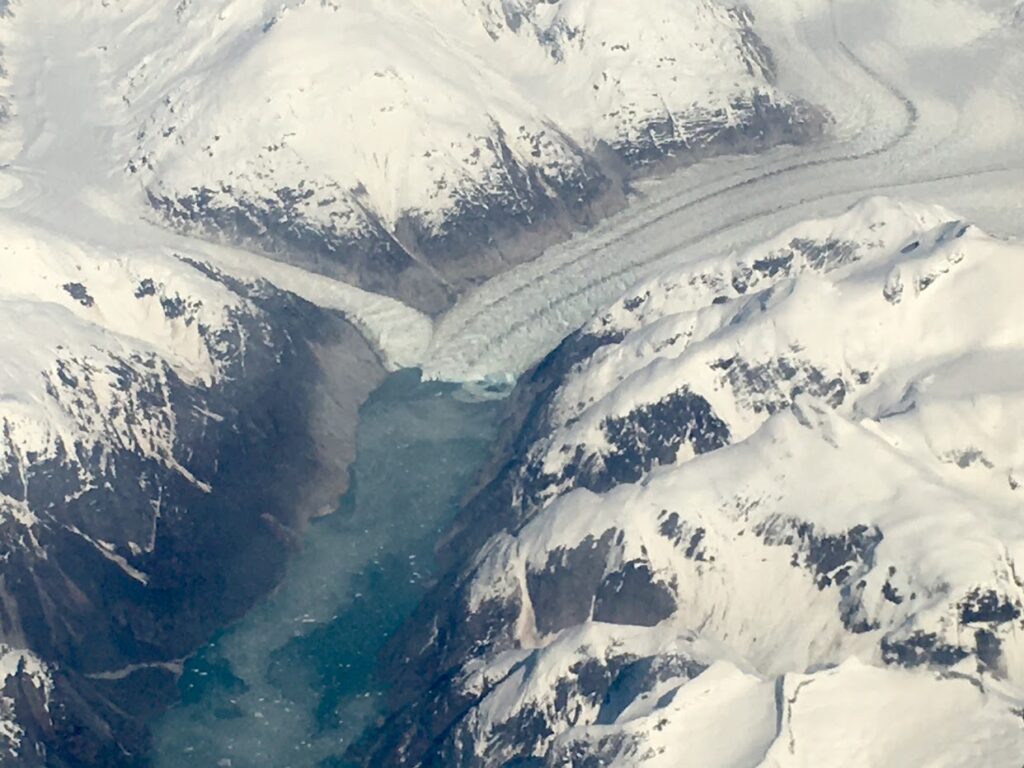
Shipmates Dick and Marjy Fiddler took this photo of the Baird Glacier as they flew home after the voyage. The photo shows where we were paddling some hundreds of metres from the glacier front. Photo: © Dick & Marjy Fiddler
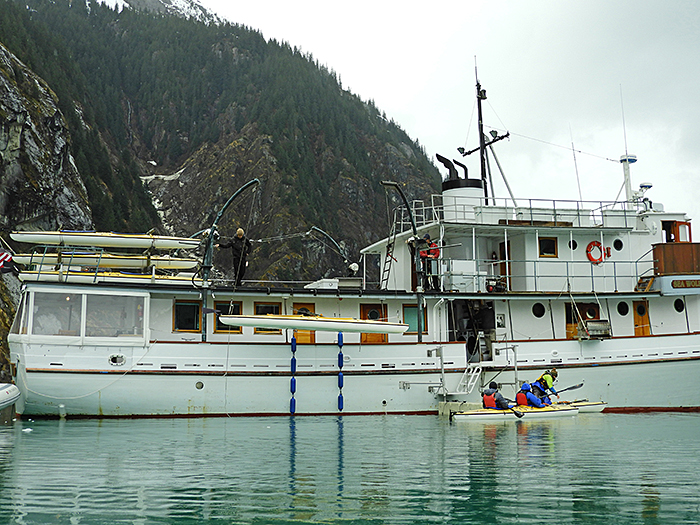
Kayak operations at the Sea Wolf. The paddlers enter and leave the kayaks from the float on the right. The kayaks are winched up to be stowed on the upper deck.
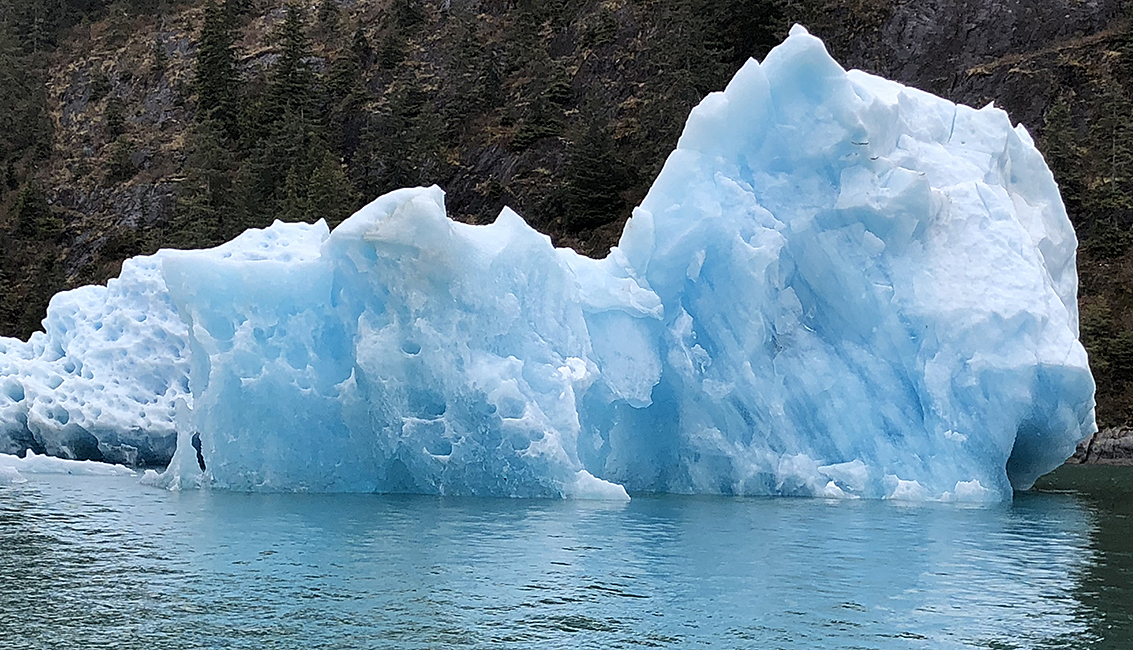
A lovely blue iceberg – Dawes Glacier, Endicott Arm. Photo: © Alan Burger
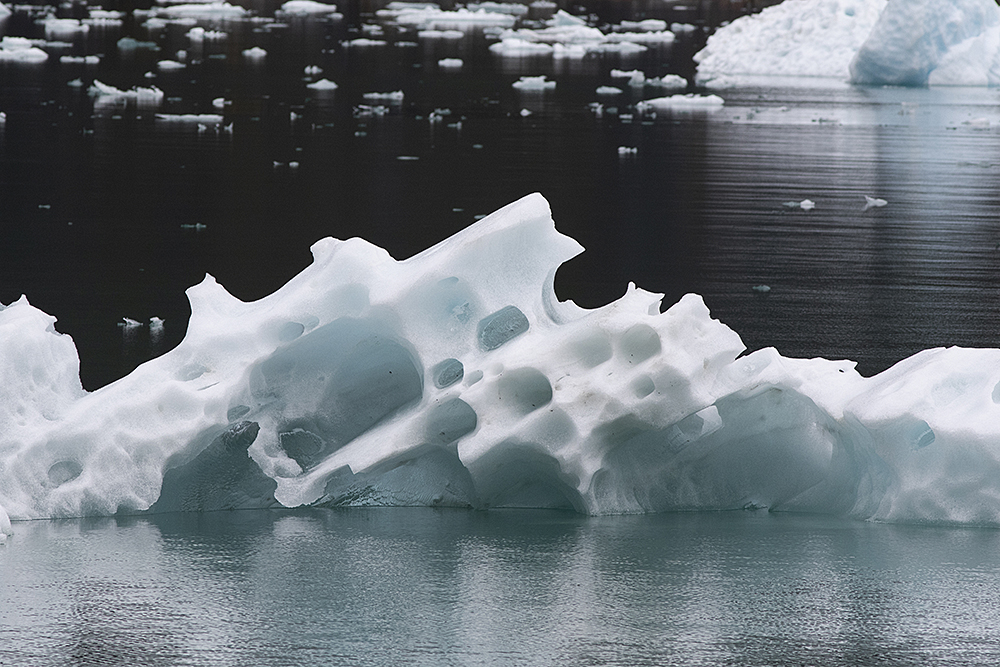
Wonderful shapes carved in ice by the movement of water. Photo: © Alan Burger
Our next stop was Ford’s Terror – an aptly-named finger of ocean that sneaks up a crack in the mountains for 8 km. We had hoped to take the skiff up this reach but it can only be done at slack tide. When the tide is rising or falling the rushing water produces an impressive (and terrorizing) set of rapids at the entrance. With fading light we ran out of time to get slack tides so had to move on.
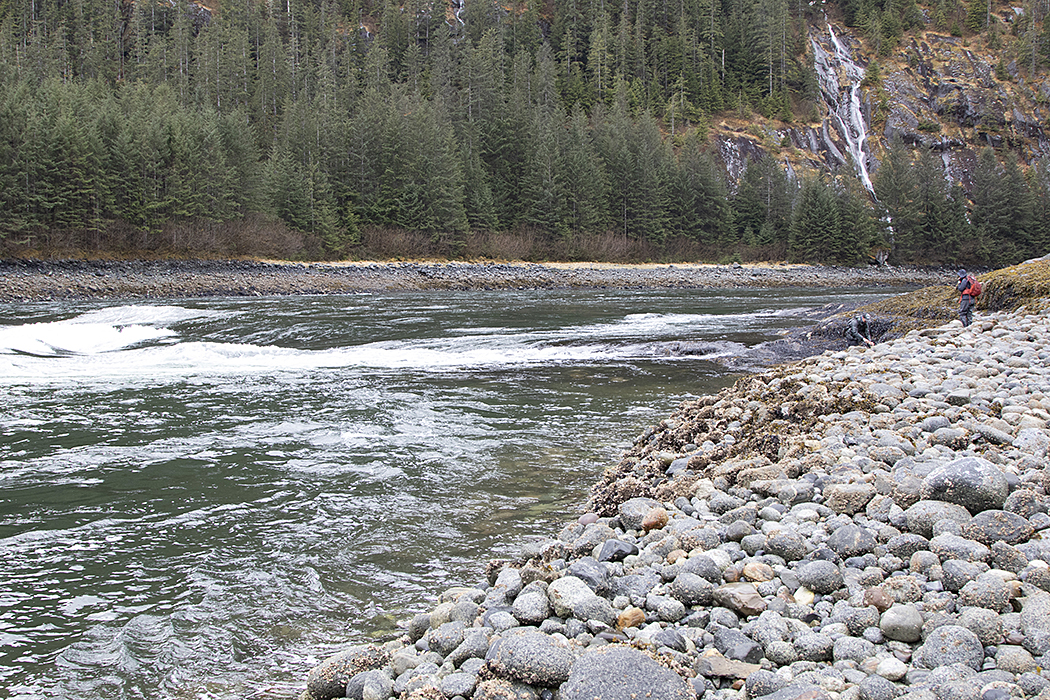
Ford’s Terror – what looks like a river coming out of the mountains is actually the ocean, emptying out at low tide from an 8 km-long narrow arm.
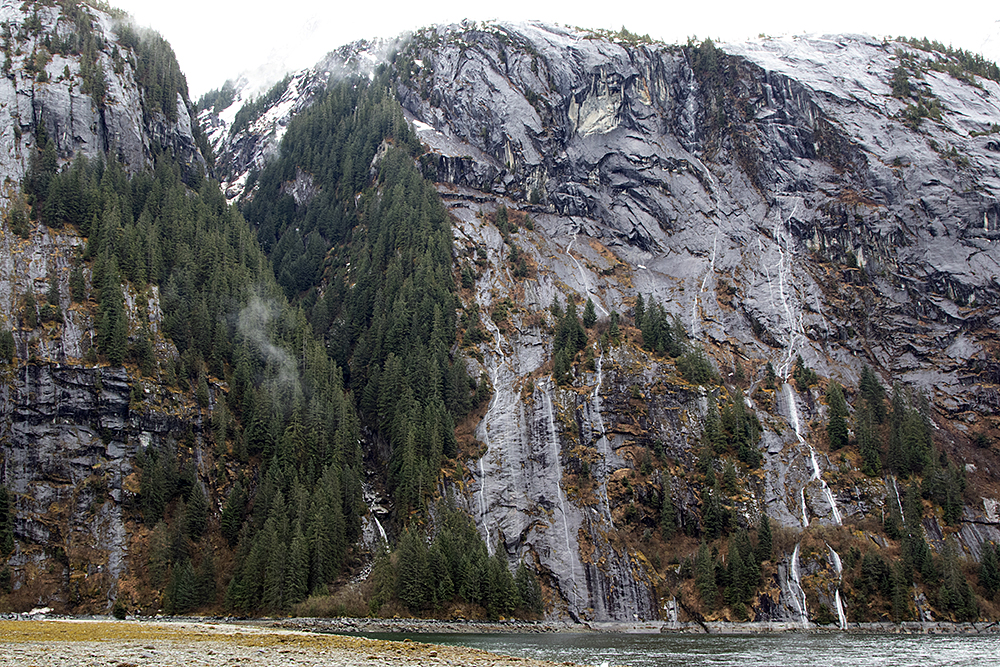
Glaciated cliffs, waterfalls and tough trees growing in unexpected places – typical of southeast Alaska. Ford’s Terror, Endicott Arm.
As our last evening approached we were still missing one highly characteristic Alaskan critter – a Brown Bear. But Hans knew of a big meadow near the entrance to Endicott Arm where bears were often seen. So we headed there. Sure enough, as we approached a big bruin came ambling along the grassy meadow. Bears had only recently emerged from their hibernation dens, so this fellow was a bit lean but in good shape.
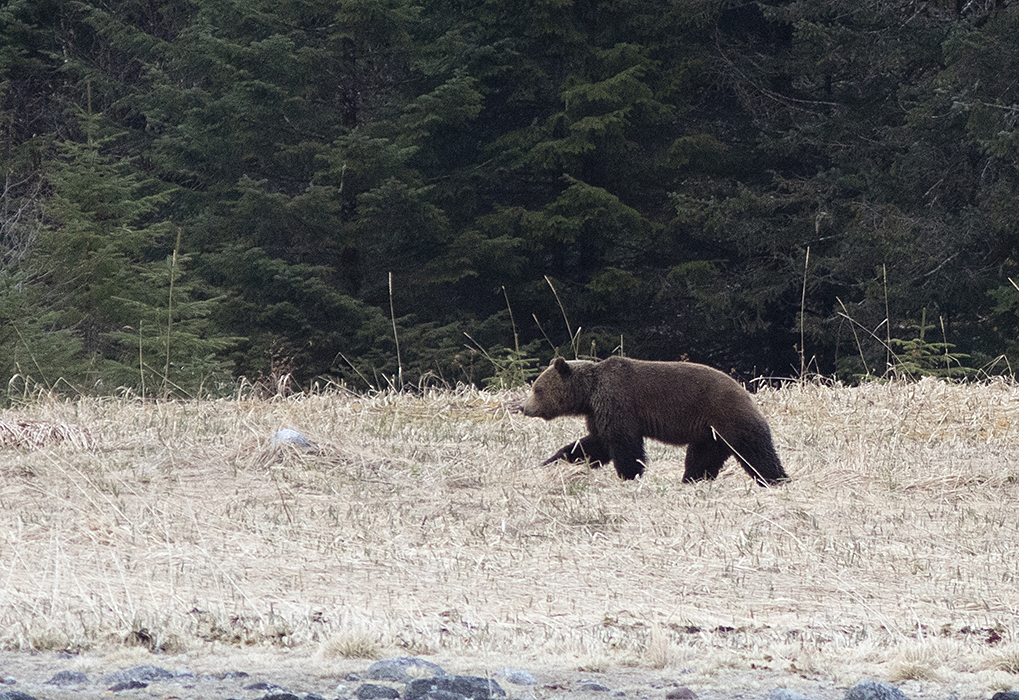
A big Brown Bear ambling across the meadow near the end of the day, 27th April.
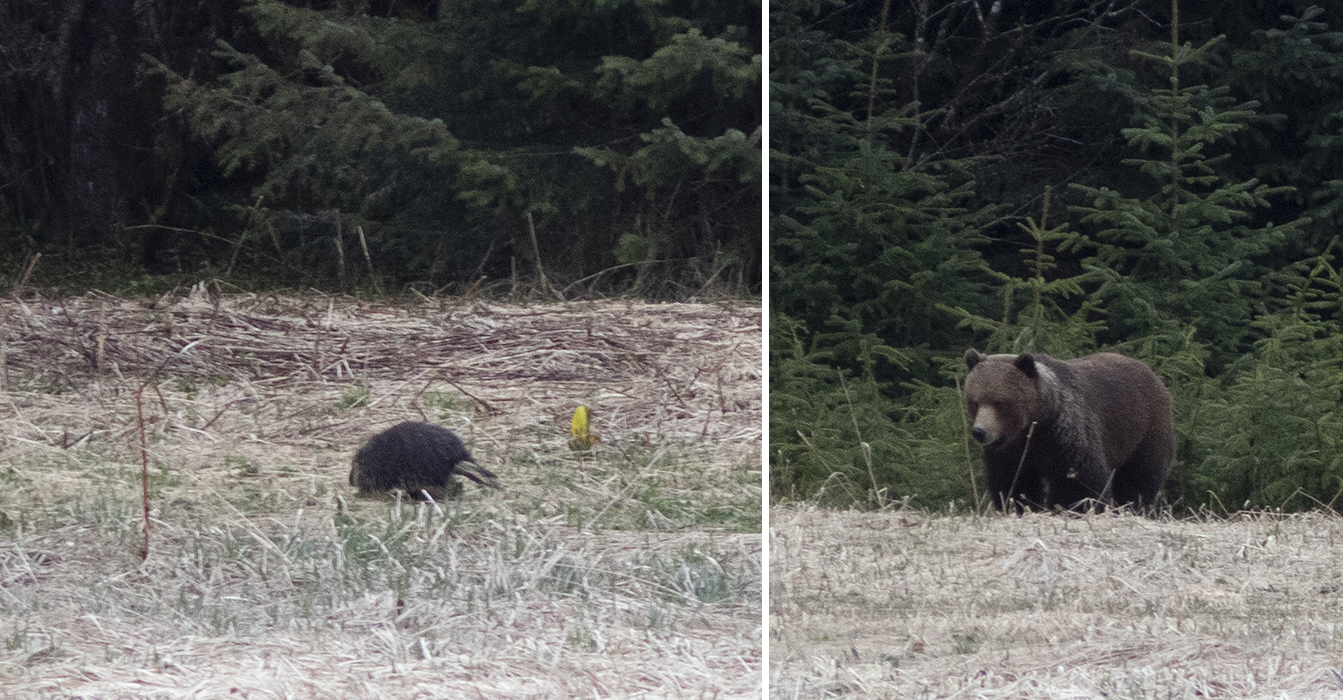
As the bear entered the forest edge, a Porcupine came scurrying out and headed off across the meadow away from the bear. Having a Brown Bear and a Porcupine in view at the same time was a special treat to end the day.
The next morning we cruised up Stephen’s Passage to Juneau – which was the end of a very special and wonderful voyage.
Checklist of birds and mammals that we saw on the Alaska voyage: Sea Wolf 2022 – Bird and Mammal Log final
A day later I was seeing Canyon Wrens and Bighorn Sheep in the dry Okanagan Valley of southern British Columbia.
~~~~~~~~~~~~~~~~~~~~~~~~~~~~~~~~~~~~~~
